Fall is when honey mushrooms (Armillaria spp) show up in the woods, and when they arrive, you’ll know it! They often fruit in massive clusters, sometimes covering the entire base of a tree or stump. These large golden mushrooms are edible, but you must be extremely clear on your identification because there are some complicated lookalikes.
In North America, there are several honey mushroom species. There are actually probably more, but DNA studies are still ongoing. There are two species in particular, though, that are well-known and sought after edibles.
If you’ve found a bunch of these and are looking for some preparation and cooking ideas, check out our guide How To Prepare Honey Mushrooms: Cleaning, Prepping, and Cooking.
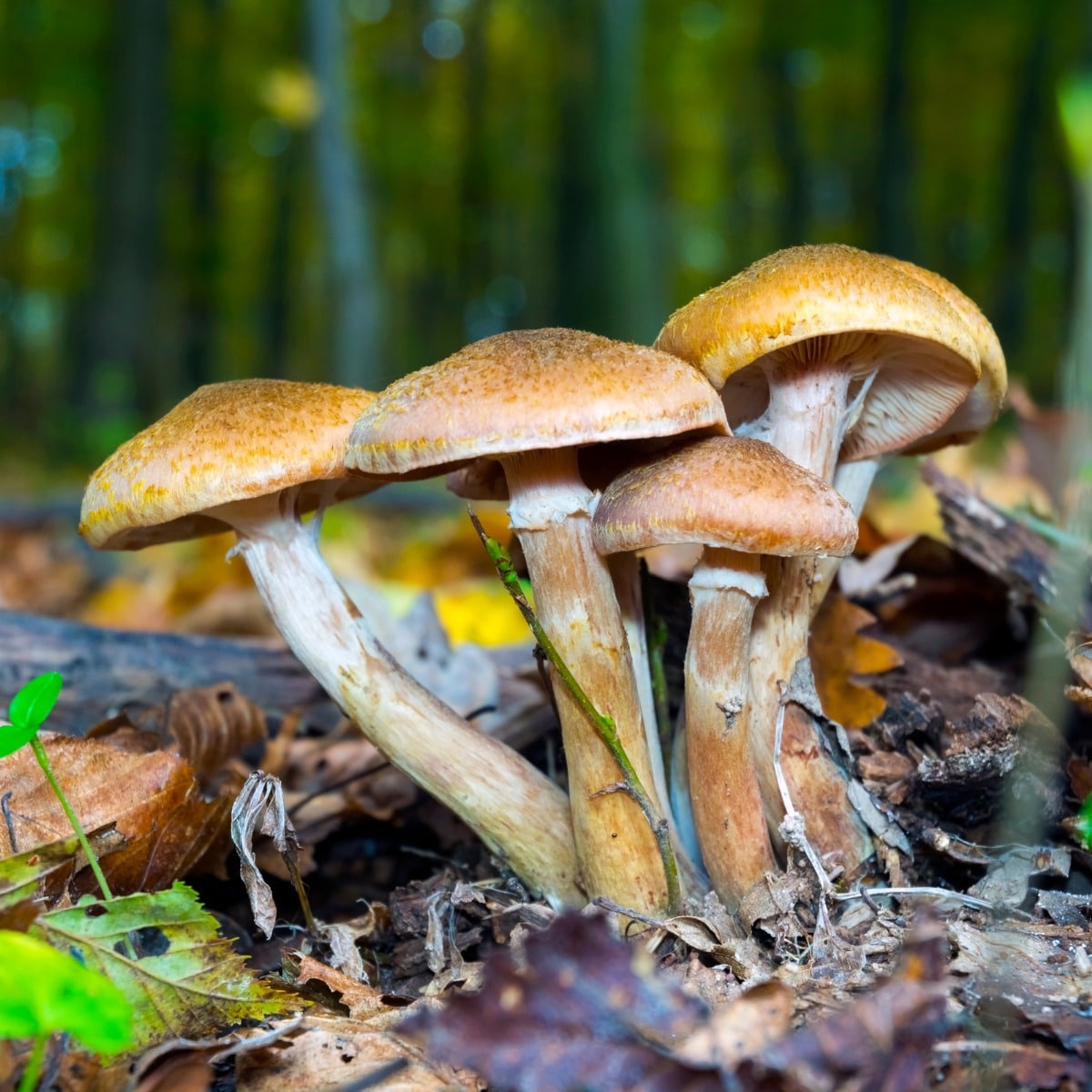
Honey mushrooms can be tricky to identify, and caution is paramount. These fungi have several lookalikes, some of which are toxic. The Deadly Galerina, for instance, is strikingly similar to young honey mushrooms, and it can be lethal if eaten. To be safe, it’s crucial to carefully examine all features, including cap texture, gill attachment, and stem characteristics. A spore print is essential for a positive identification of these species.
- Scientific Names: Armillaria
- Common Names: stump mushroom, stumpie, honey mushroom, pipinky or pinky
- Habitat: Dead and decaying wood
- Edible: Yes
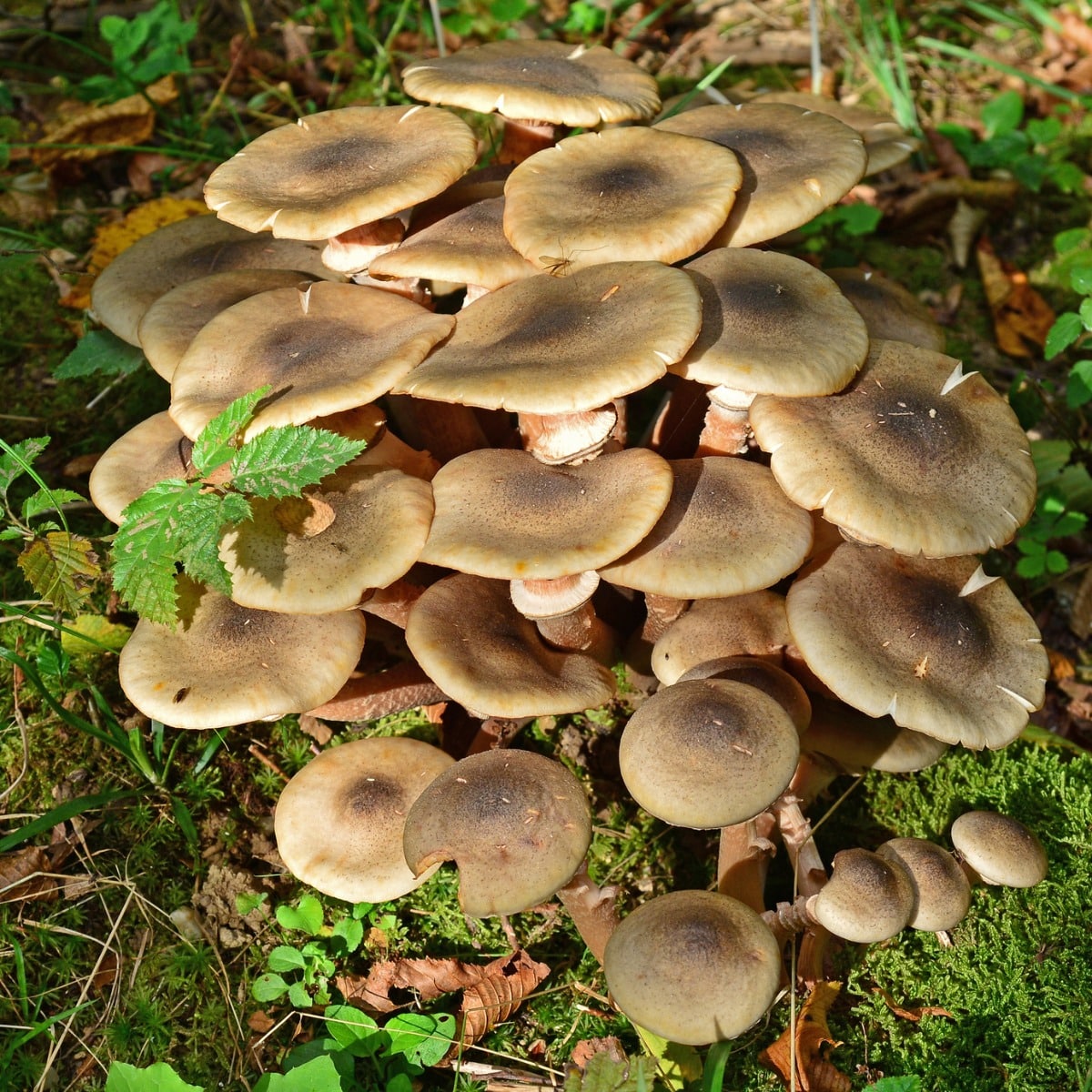
Jump to:
- Honey Mushroom Species Overview
- The Largest Honey Mushroom In The World
- Physical Characteristics of Honey Mushrooms
- Habitat and Growing Conditions
- Honey Mushroom Common Lookalikes
- Cooking With Honey Mushrooms
- Honey Mushroom Ecology
- Identifying Honey Fungus Infection In Trees
- The Curious Case of Entoloma abortivum and Armillaria
- Honey Mushroom Medicinal Uses And Research
- Common Questions About Honey Mushrooms
Honey Mushroom Species Overview
The genus Armillaria contains a widespread and common group of fungi known as honey mushrooms. Honey mushrooms are recognized as one of the most widely distributed mushrooms globally. Some honey mushroom species glow in the dark. This bioluminescence is known as foxfire.
There are approximately 40 species of Armillaria worldwide and around 15 occur in North America. Some of these are extremely difficult to differentiate without a microscope, but all of them are edible, so there is not a concern about separating them out. It is more important to make sure that you have a honey mushroom to begin with!
For decades, Amrillaria mellea was used as a catch-all for all members of this group, especially in North America. Folks suspected there were differences but it wasn’t until the 1970’s that microscopic and mating studies were done and eventually split out the different species. To this day, though, many people still use only that species name because it is easier and also because it is super difficult to tell some of them apart.
Two main species in North America are foraged for the table primarily because they are the most common and prolific. The other species are less common to rare.
Armillaria mellea
Armillaria mellea is the classic honey mushroom and type species of the genus. It’s known for its honey-yellow to red-brown caps, which can grow up to 6 inches in diameter. This species is widespread throughout Britain, Ireland, mainland Europe, and North America. A. mellea is notorious for its parasitic nature, attacking coniferous and broad-leaf trees. It can cause significant damage to forests as it spreads.
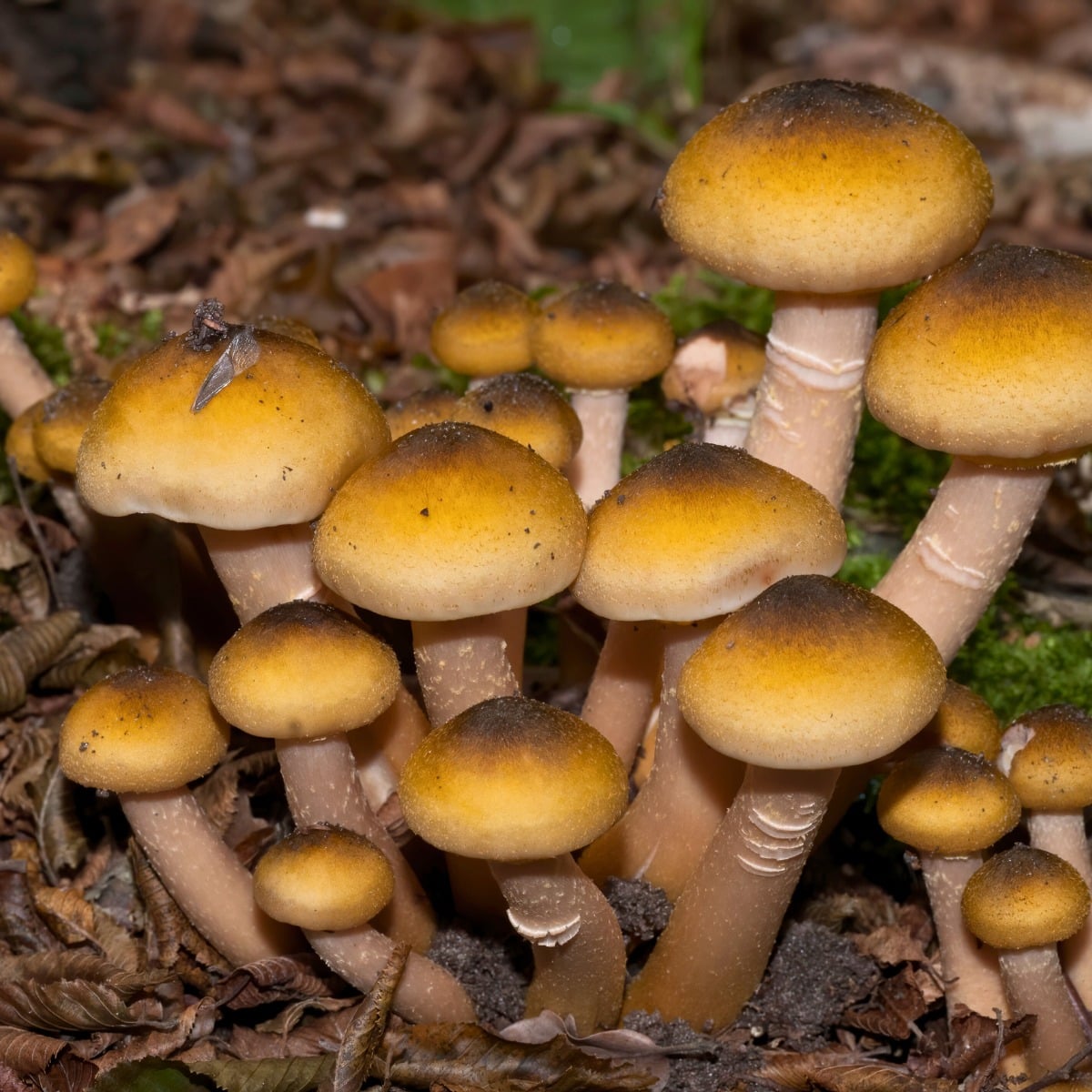
Armillaria tabescens (Desarmillaria tabescens)
Armillaria tabescens, also known as the ringless honey mushroom, is easily identified among North American Armillaria species. It lacks a ring on its stem, setting it apart from its relatives. This species typically grows in clusters on hardwoods in eastern North America, from the Great Lakes southward and west to Texas and Oklahoma. A. tabescens prefers warm and dry regions and can be found at altitudes ranging from sea level to 4,300 feet.
The ringless honey mushroom is usually the first one to show up late summer into fall. Depending on the climate and rainfall, they start fruiting from late August to early September.
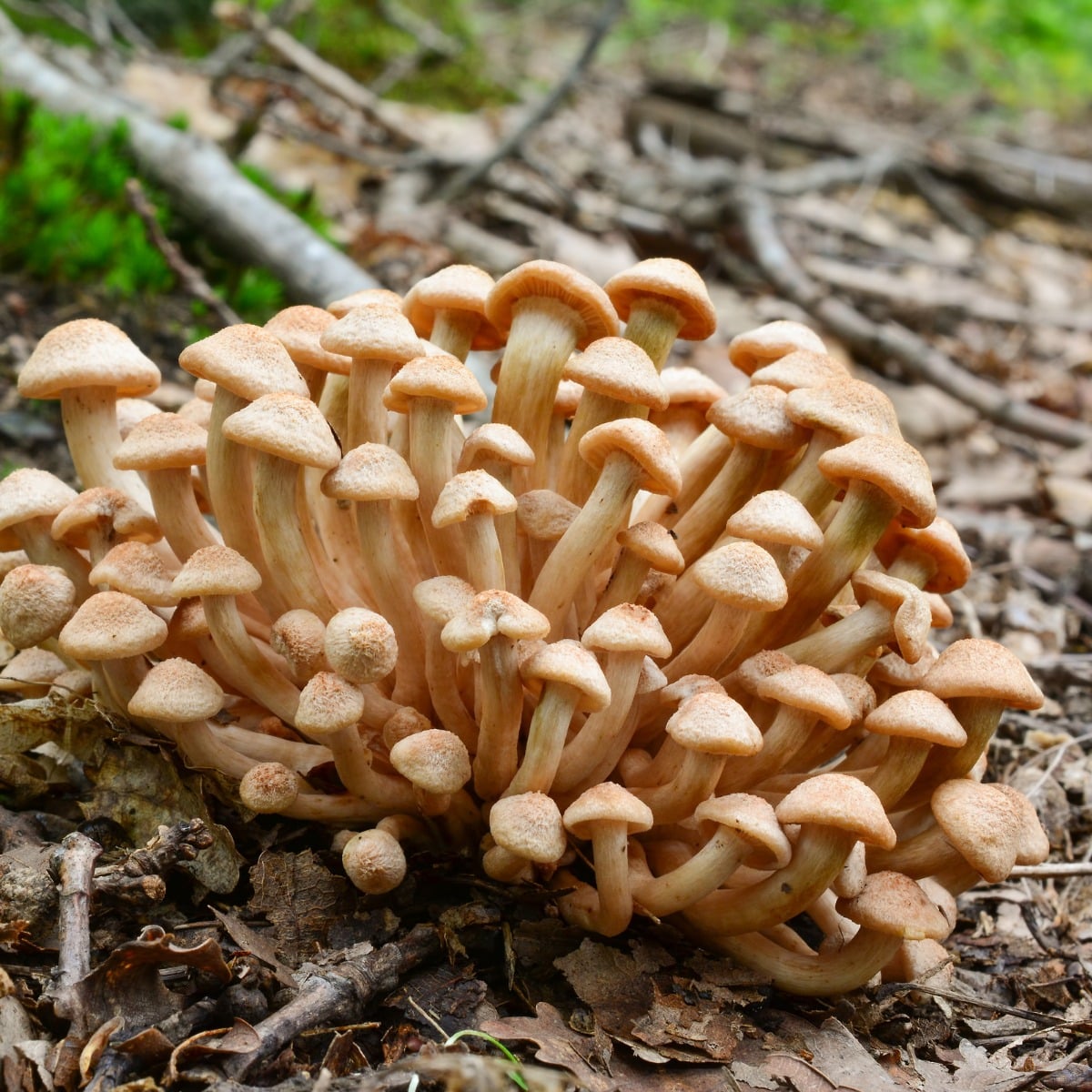
Other Common Species
While A. mellea and A. tabescens are well-known, there are several other notable Armillaria species. These include Armillaria ostoyae, often called the Dark Honey Fungus, which has distinctive dark scales on its cap and grows primarily on conifers, although it can grow on hardwoods as well. Armillaria gallica is distinguished by a bulbous stem and a fleeting, cobweb-like ring. Armillaria calvescens grows on maple trees in Canada and New England. It can be found on other hardwoods in the western United States. Each species has its unique characteristics, but all share the honey mushroom’s distinctive clustered growth pattern and parasitic nature.
All these Armillaria species are edible when thoroughly cooked.
Tom Volk created a great KEY FOR HONEY MUSHROOM IDENTIFICATION — if you think you’ve found honies but they don’t match the two primary species, check this key; it should point you the right way.
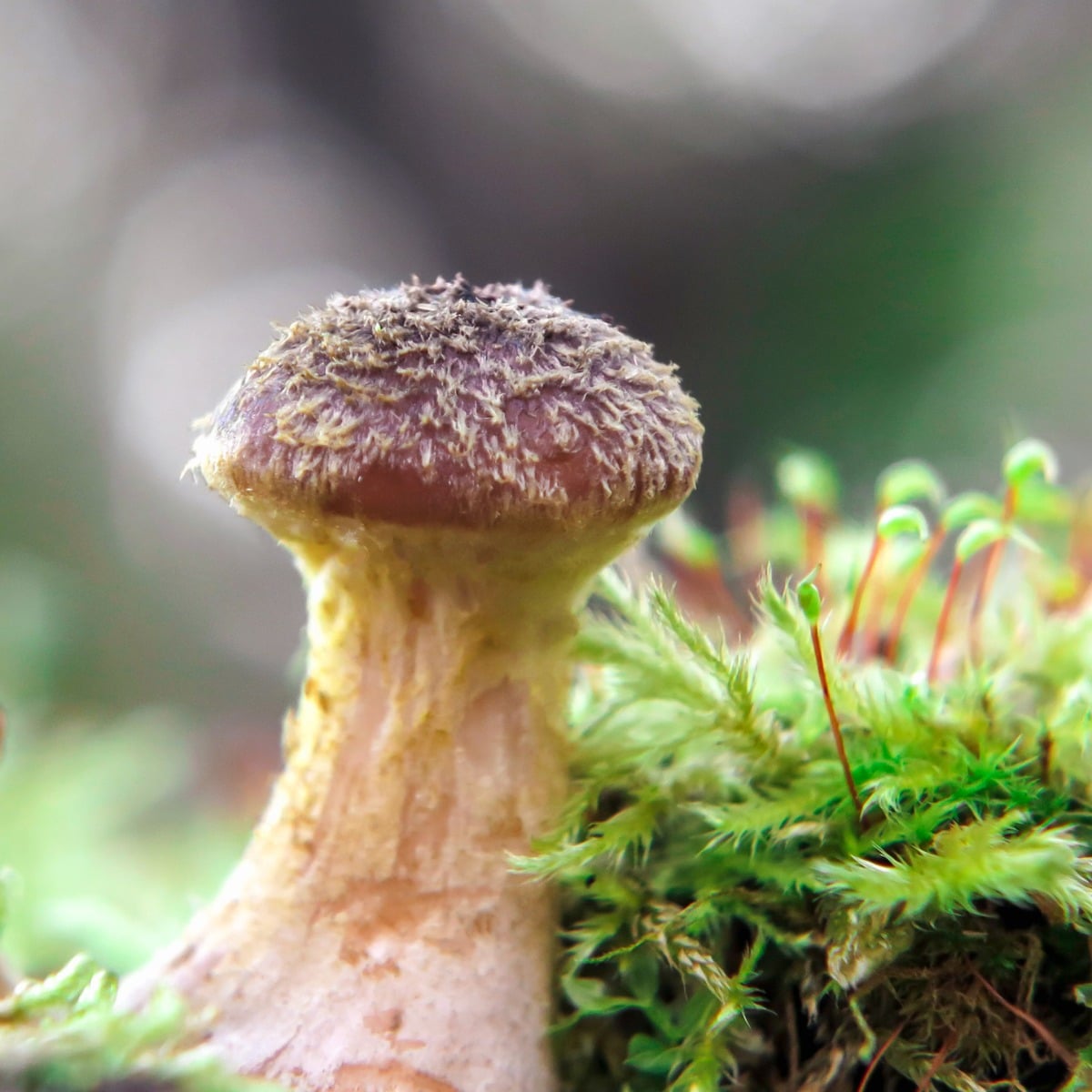
The Largest Honey Mushroom In The World
In the Malheur National Forest in Oregon, there is a remarkable organism called the “Humongous Fungus.” This massive specimen of Armillaria ostoyae (also called Armillaria solidipes) is believed to be the largest living organism on Earth by mass, area, and volume.
This incredible fungus covers an astounding area of approximately 2,385 acres (965 hectares), equivalent to about 1,350 soccer fields. To put its size into perspective, if all its mass were gathered together, it could weigh anywhere from 7,500 to 35,000 tons – that’s more than 200 gray whales!
The age of this giant organism is equally impressive. Scientists estimate it to be between 2,400 and 8,650 years old, based on its current size and annual growth rate of 1 to 3 feet per year. This makes it not only the largest but also one of the oldest living organisms on the planet.
Because the honey mushroom is parasitic, the area where it is growing is noticeable for its vast swaths of dead and dying trees.
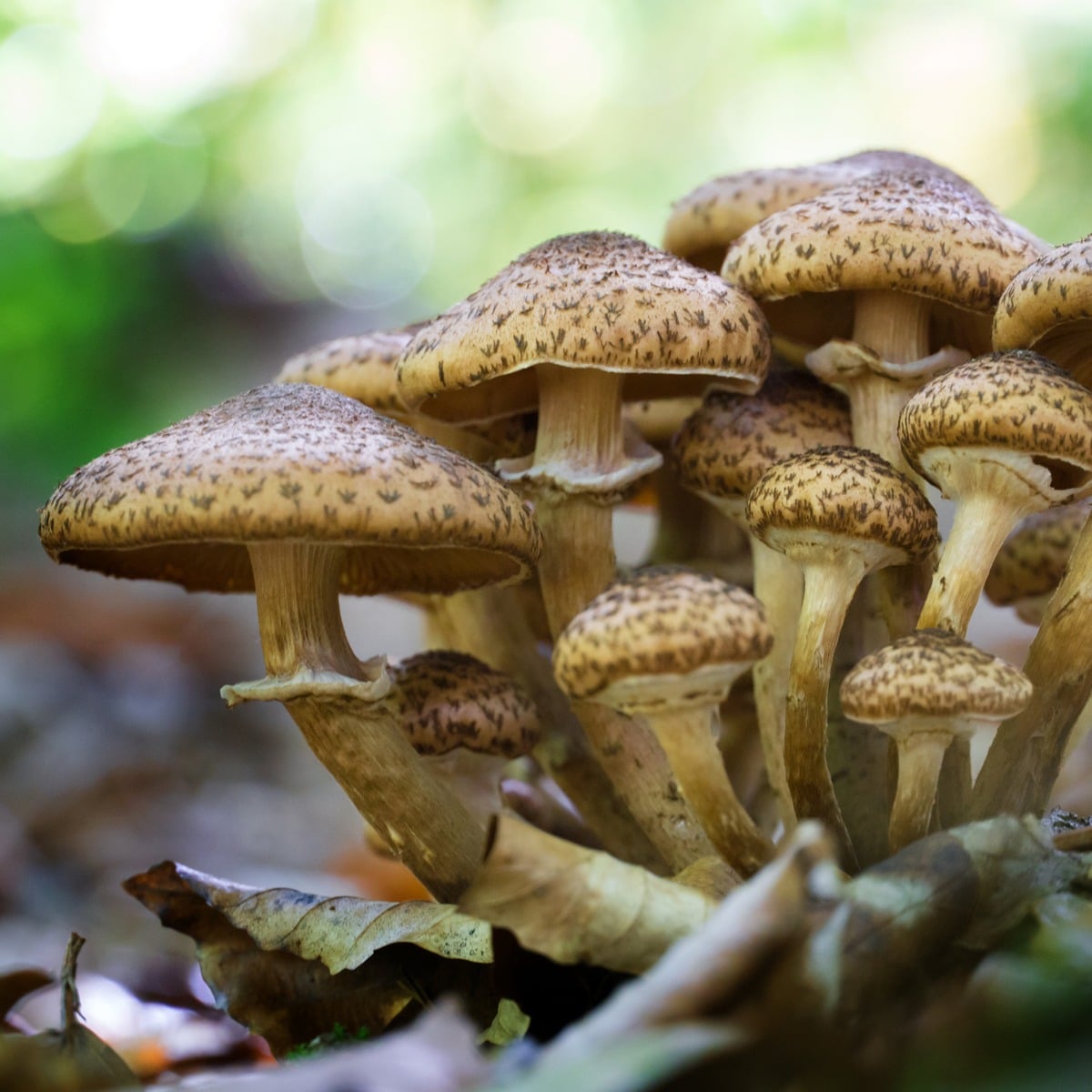
Physical Characteristics of Honey Mushrooms
Cap
Honey mushrooms have caps that start as small round buttons and quickly grow to 2 to 6 inches in diameter when fully opened. Their color typically ranges from honey-yellow to reddish-brown. Some species have very scaly caps when young while others are bald or have minimal scales that dissipate with maturity.
The caps flatten with maturity and not uncommonly, the cap edges flip upwards to show off the gills. The edges may also split or become wavy depending on the age and weather conditions. The cap’s flesh is white and firm.
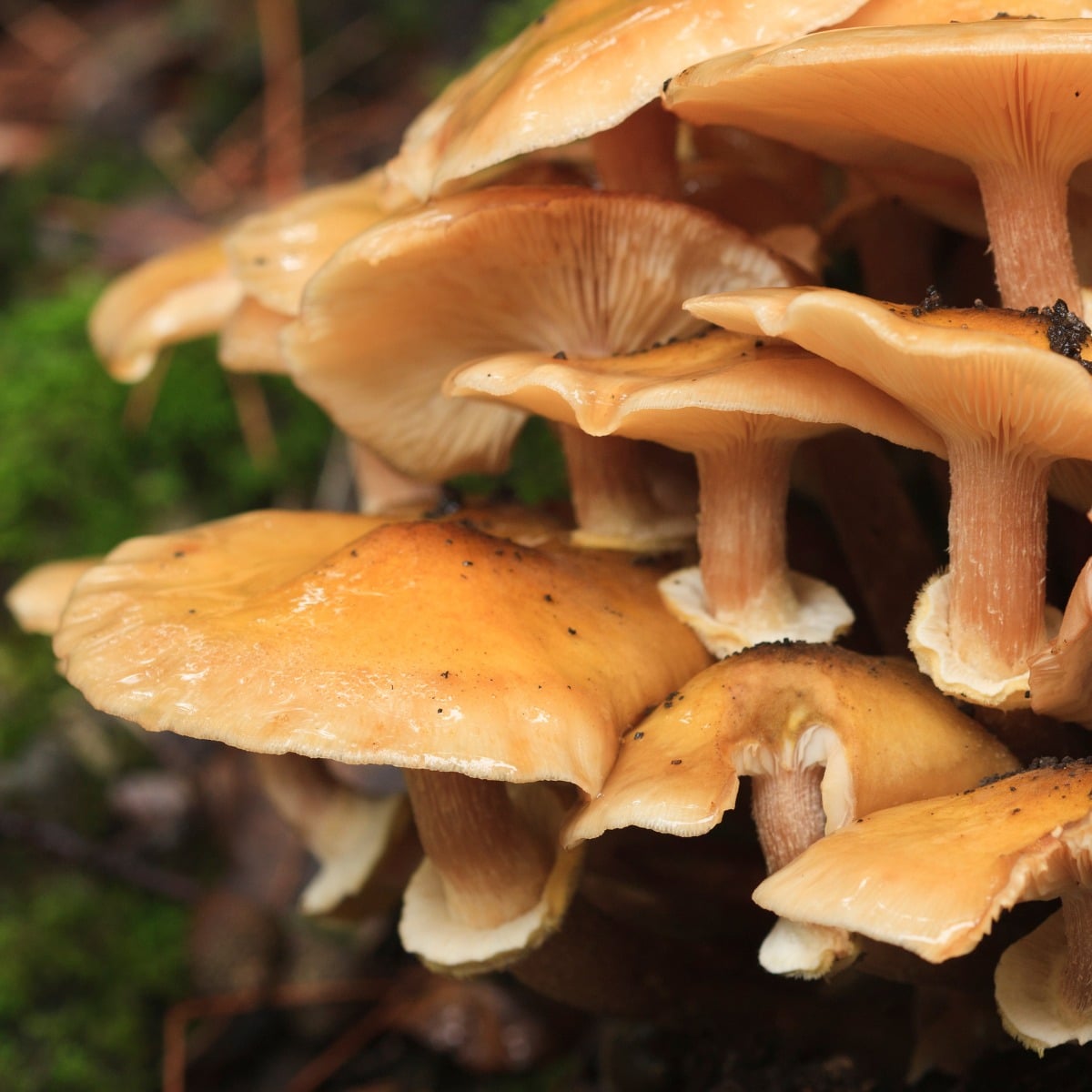
Stem
The stem of honey mushrooms is chunky and large compared to the cap size, especially when young. It starts pale and darkens from flesh-colored to brown and nearly black with age. Often, the stem has scales and a wooly or felty texture. It measures 2.4 to 6 inches tall.
Stems are fibrous when young. They do not snap or break easily. With age, they usually turn hollow. The classic honey mushroom has a distinctive ring around the upper portion of the stem (the ringless honey mushroom does not have this).
Honey mushrooms fruit in clumps with stems that are fused at a focal point. When you go to collect one, you’ll be pulling up an entire cluster. They rarely fruit individually but it does happen. A key identifier, though, is the tightly packed stems connected at the base.
Gills
The gills are initially covered by a pale yellow veil, which becomes a substantial ring on the stem as the cap grows (for the classic honey mushroom — the ringless honey mushroom does not have this ring). The gills are off-white, gradually darkening and developing dark rusty spots at maturity. They are closely spaced, adnate (broadly attached to the stem), and sometimes slightly decurrent (running down the stem).
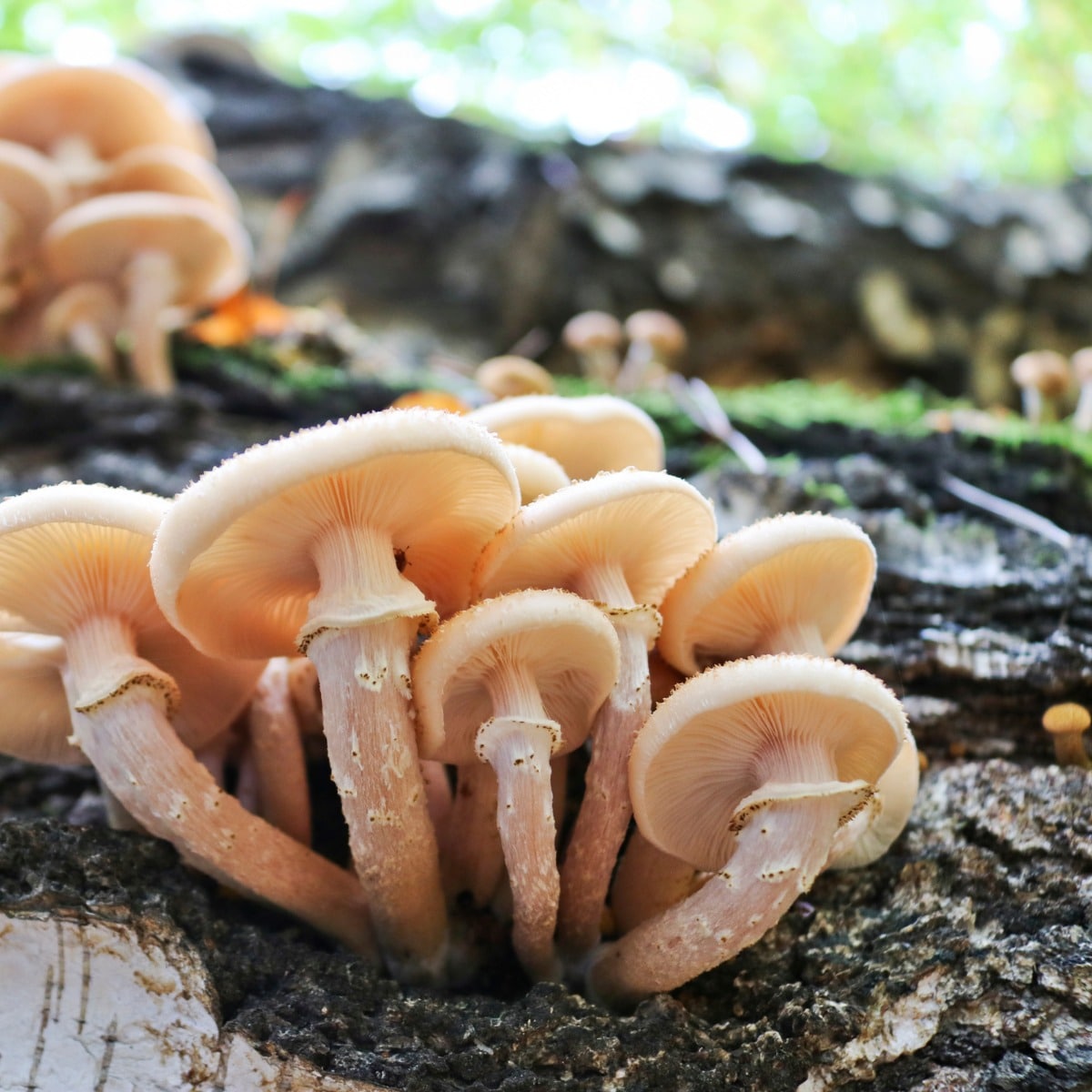
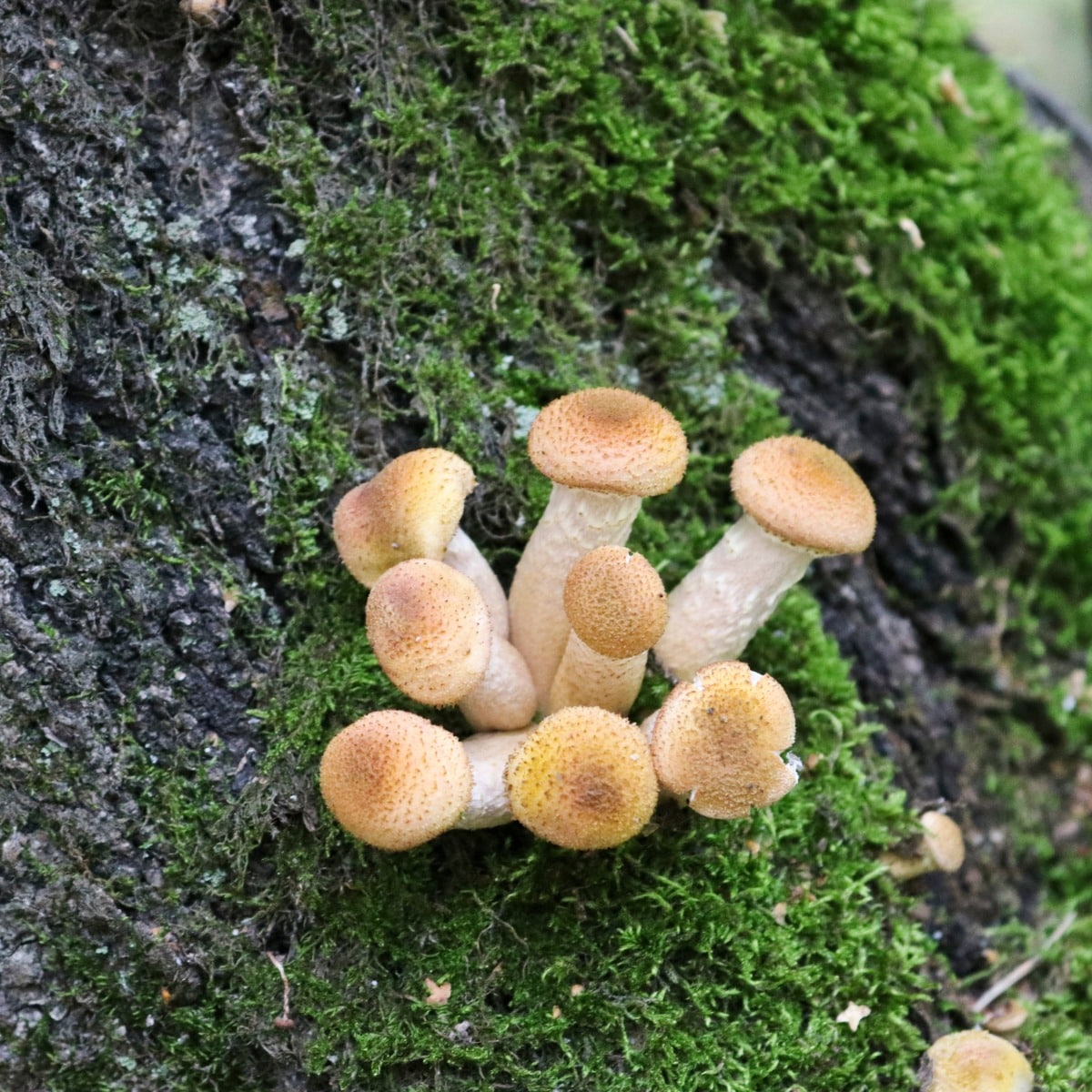
Flesh and Odor
The flesh of honey mushrooms is white and does not change color when cut or bruised. They do not have a distinctive smell or taste.
Spore Print
A crucial identification feature of honey mushrooms is their spore print. Honey mushrooms produce white spores, which show up clearly on dark paper. This white spore print is a key characteristic that helps distinguish honey mushrooms from potential lookalikes.
Armillaria mellea
- Honey-colored cap with tiny, dark scales or no scales – most often is bald
- Cap: 2-6 inches wide, honey-colored to yellowish-brown, may have a darker center
- Stem: 2-6 inches tall, white to pale brown. Fibrous and tough.
- Gills: White to pale cream, turning pinkish with age
- Grows in clusters at the base of trees or stumps
- Often found in woodland areas or gardens
- Presence of a ring (annulus) on the stem – distinctive and robust ring
- White spore print
- White flesh
- Typically fruits in late summer to fall
- Grows in the eastern half of North America. It has been reported from northern California, though.
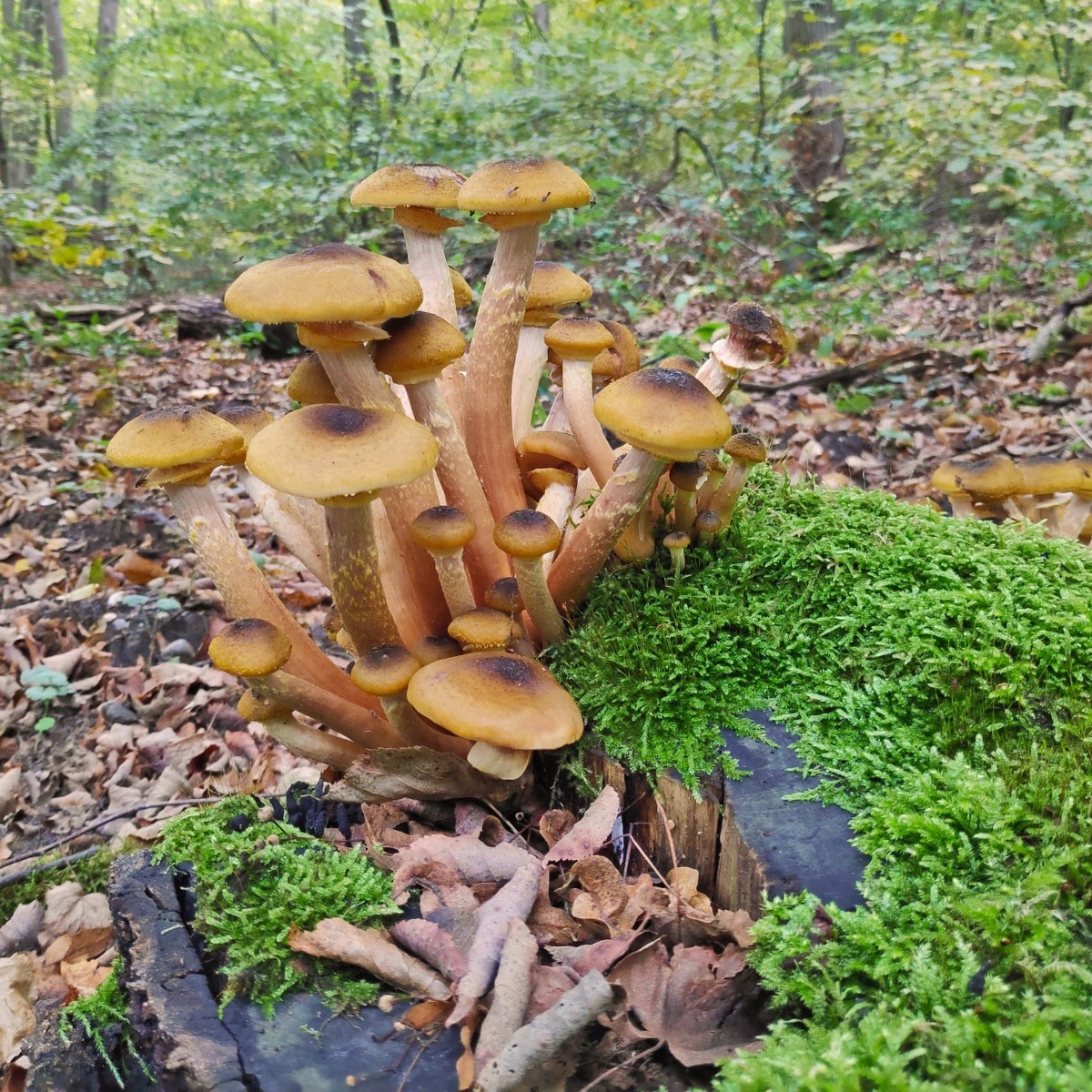
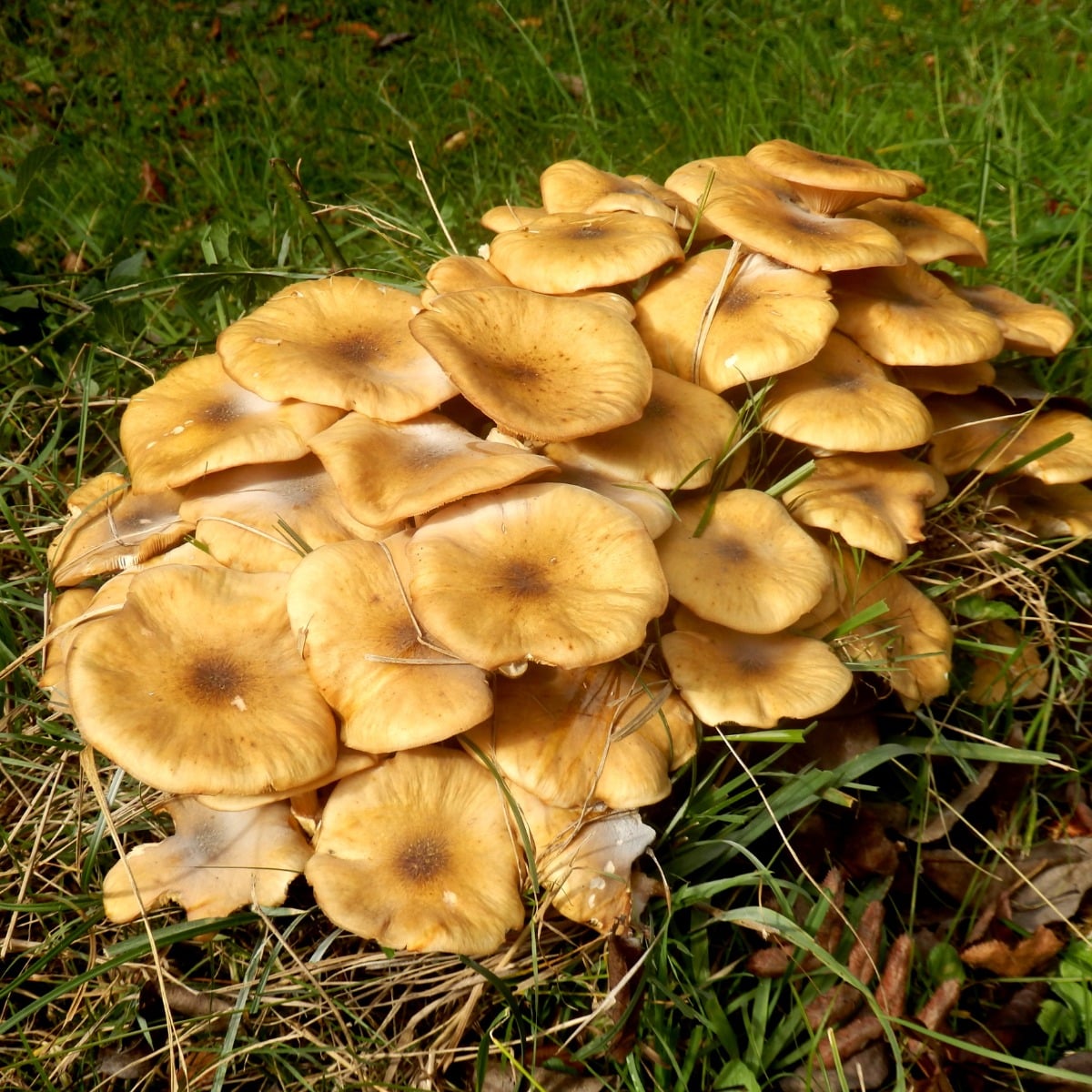
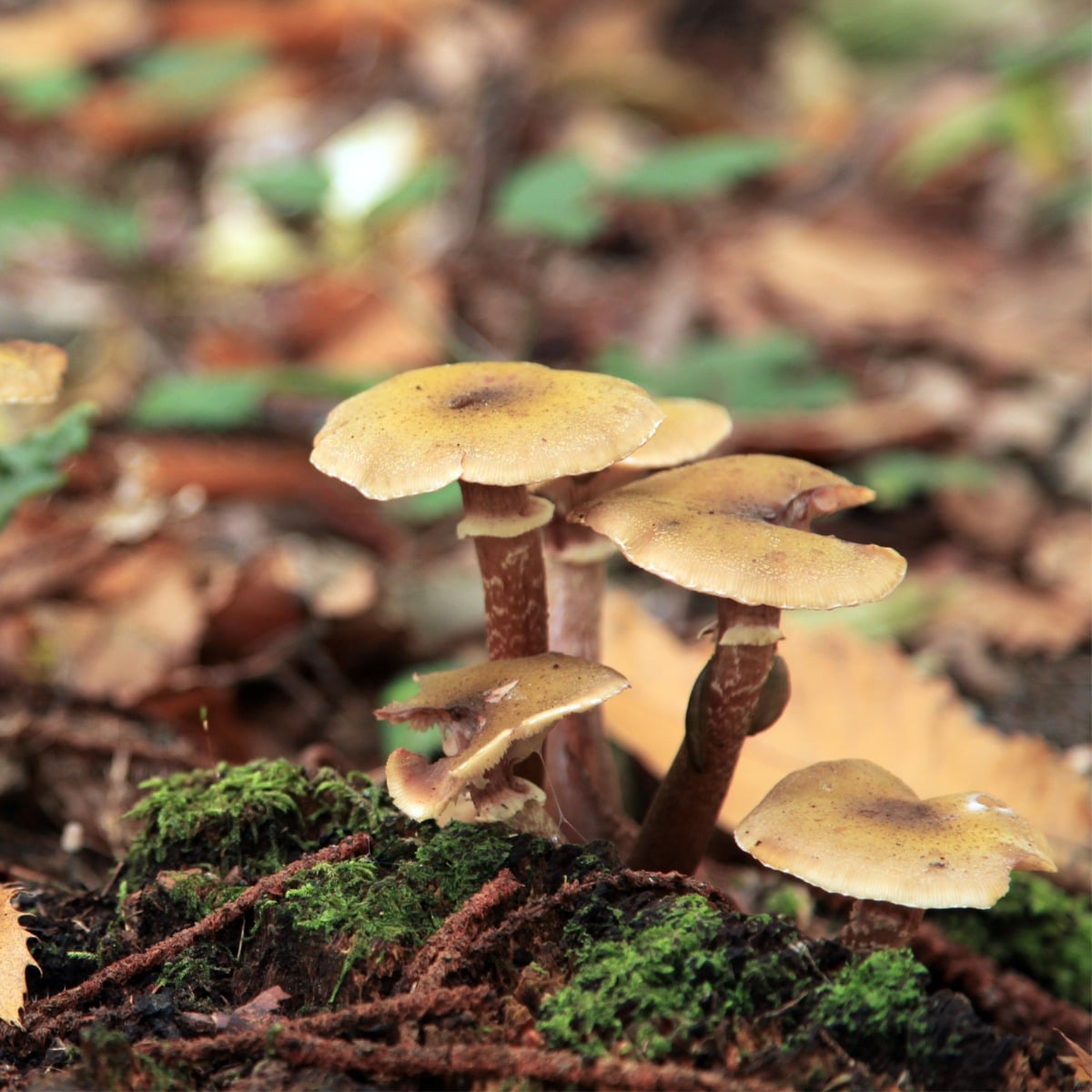
Armillaria tabescens
- Honey-brown to reddish-brown cap
- Cap: 1-4 inches in diameter, covered with small, dark scales, especially at the center. With age, caps flatten and may become depressed in the center. Scales may dissipate with maturity also.
- Stem: 2-6 inches long, same color or lighter than the cap. Fibrous and tough.
- Gills: White to cream-colored, becoming pinkish with age, closely spaced
- No ring present around the upper stem (distinguishing feature from other Armillaria species)
- Grows in dense clusters at the base of hardwood trees or stumps
- Often appears in late summer to fall
- Spore Print: White
- Flesh: White to pale buff
- Appears in eastern North America south of the Great Lakes and as far west as Texas and Oklahoma.
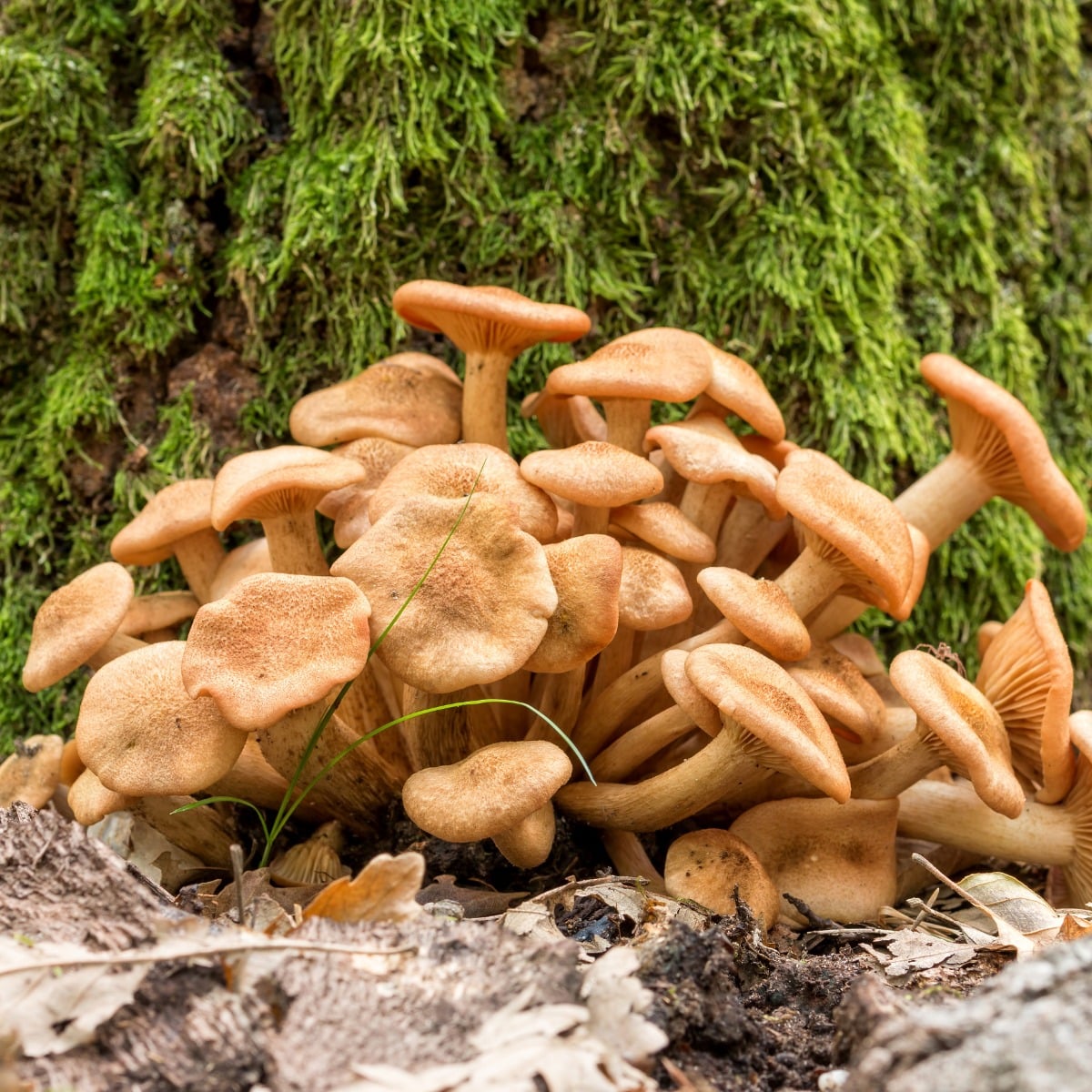
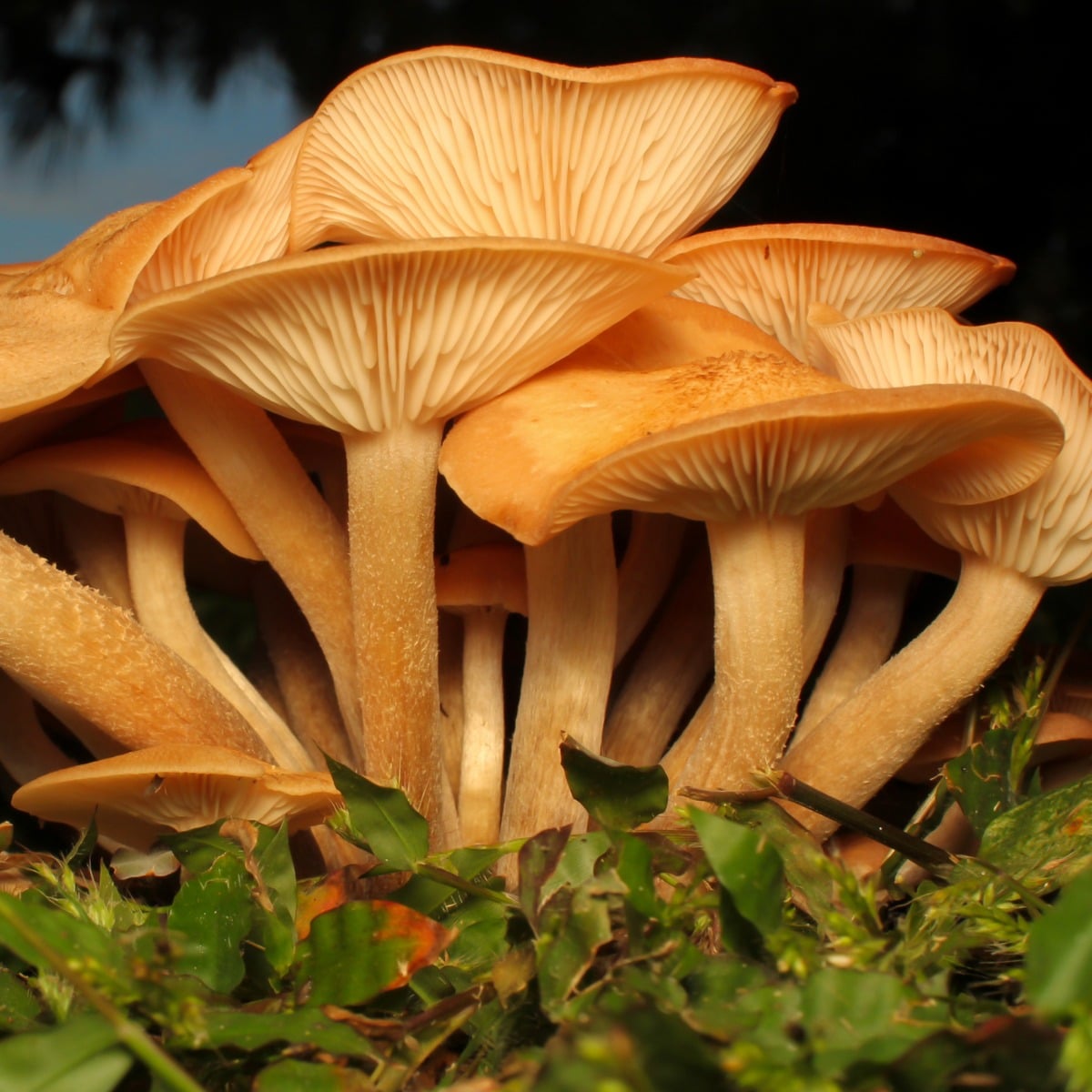
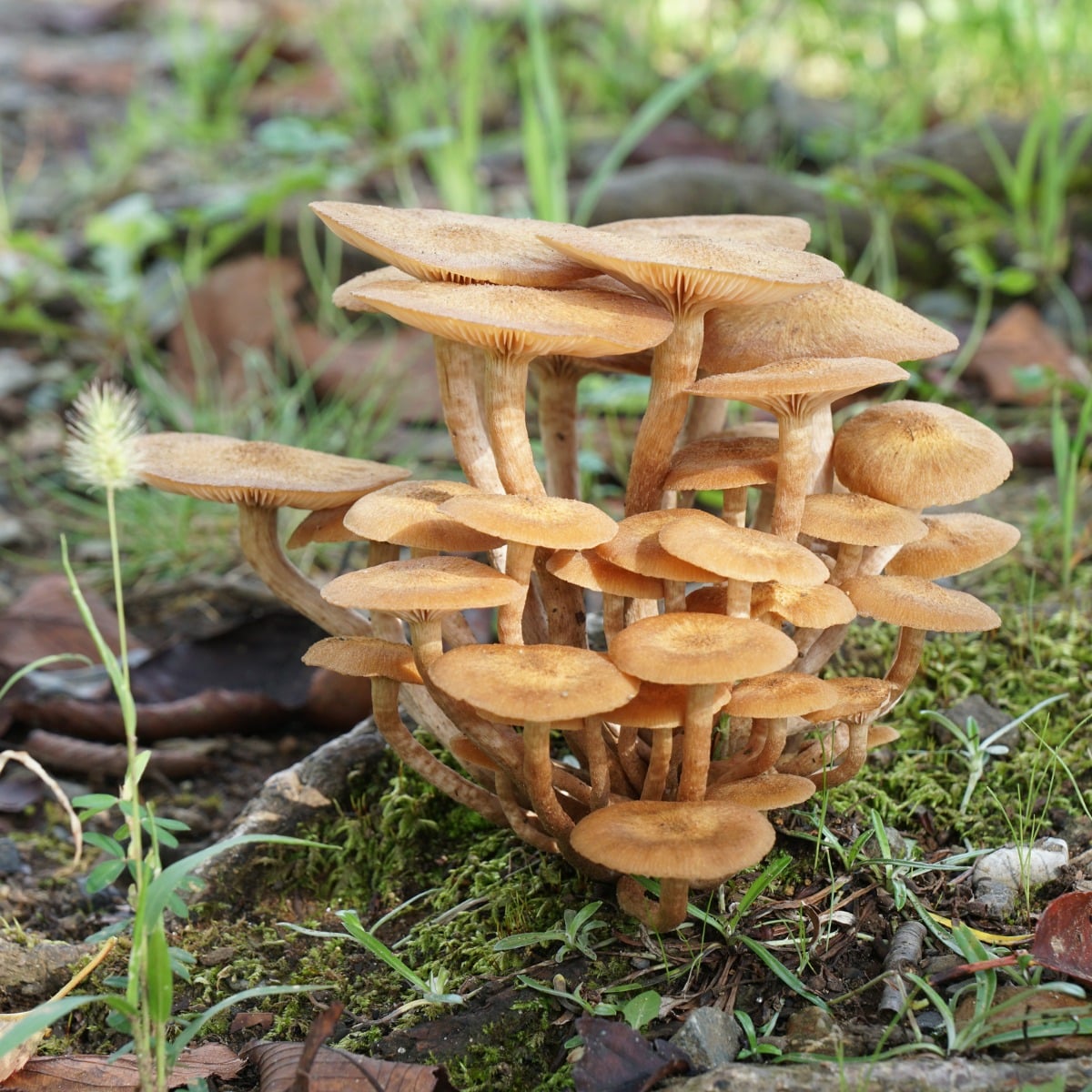
Habitat and Growing Conditions
Growth Habit
Honey mushrooms grow on dead and decaying wood, hardwoods and conifer. They sometimes look like they are growing from the ground but they’re always sourcing wood or roots below the surface. Honeys grow in dense clusters, though sometimes you will find one or two fruiting alone. They tend to fruit at the base of trees and stumps, often in crazy vast numbers with 5-8 clusters all around one tree. And sometimes, there are more than 30 individual mushrooms in a cluster!
Preferred Tree Species
Honey mushrooms have a wide range of host preferences. They can grow on living, decaying, and dead plant material, including both deciduous and coniferous trees. These fungi particularly thrive on lilac, privet, apple, flowering cherries, willow, birch, walnut, cedars, and cypresses. Interestingly, some trees show resistance to honey fungus infection. Box elder, Californian black walnut, and yew seem to be virtually immune, while fir, bamboo, hornbeam, beech, ash, junipers, larch, and oaks also display resistance.
Seasonal Patterns
Honey mushrooms typically fruit in the autumn, though they don’t appear every year. The harvesting window can be as short as a week for any one colony. In other years (usually super wet ones), you can practically trip over the honey mushrooms in the forest, and there is more to forage than is actually possible. These years, the fruiting season also tends to last several weeks.
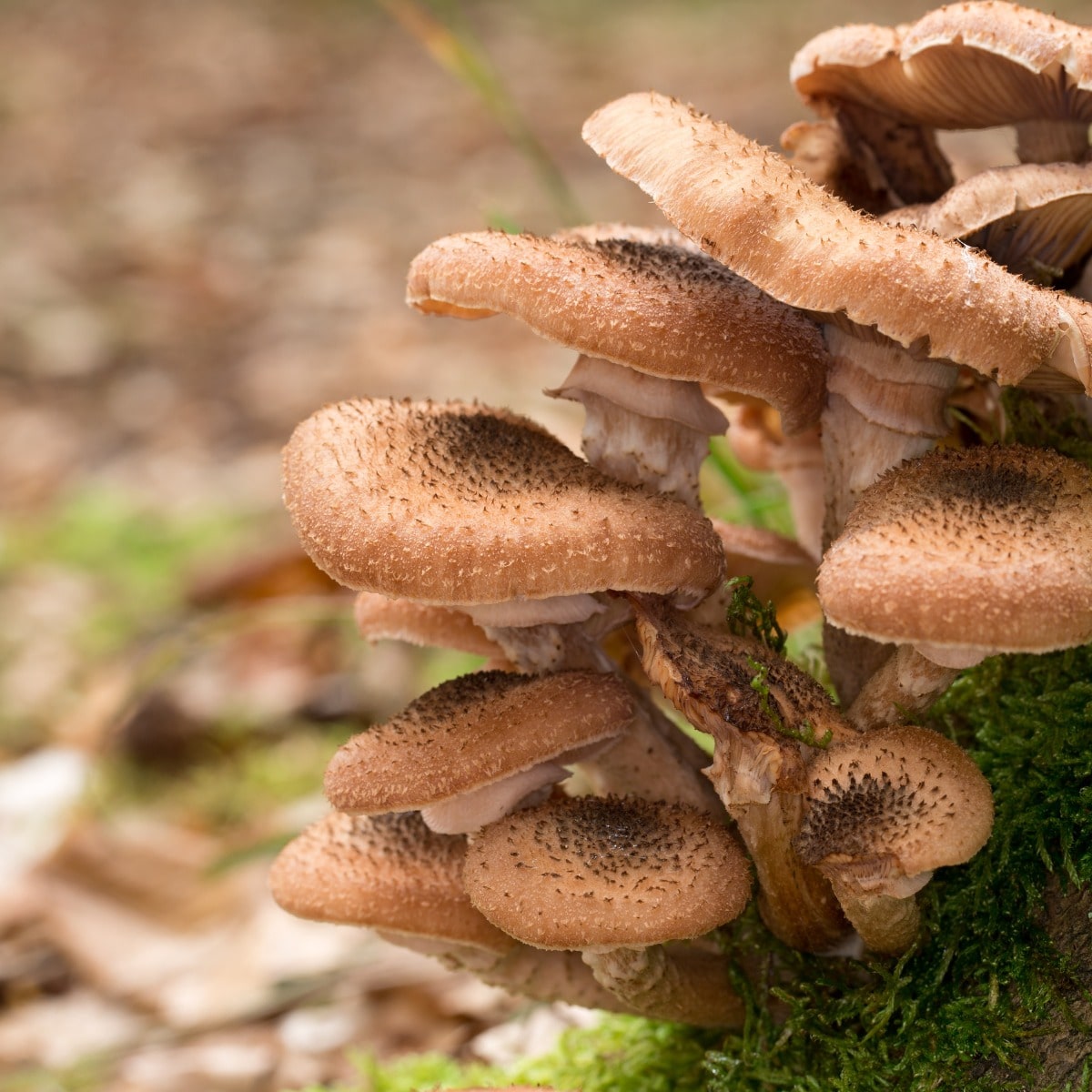
Honey Mushroom Common Lookalikes
Several mushrooms resemble honey mushrooms, so careful identification is crucial.
Deadly Galerina (Galerina autumnalis)
The deadly galerina is a extremely toxic lookalike with a lot of shared features. However, it has a brown spore print, unlike the white spore print of honey mushrooms. If you are ever in doubt, do a spore print!
Deadly galerinas are smaller than honey mushrooms, but when honeys are young and just fruiting, they can be the same size. Their caps are both brown(ish) and they both have rings around the stem, although with deadly galerinas, that may disappear with maturity. Overall, the deadly galerina isn’t as robust looking, it’s slender and more delicate looking.
Because of the similar habitat, coloring, ring around the stem, it’s best to do a spore print with any honey mushrooms you are questioning!
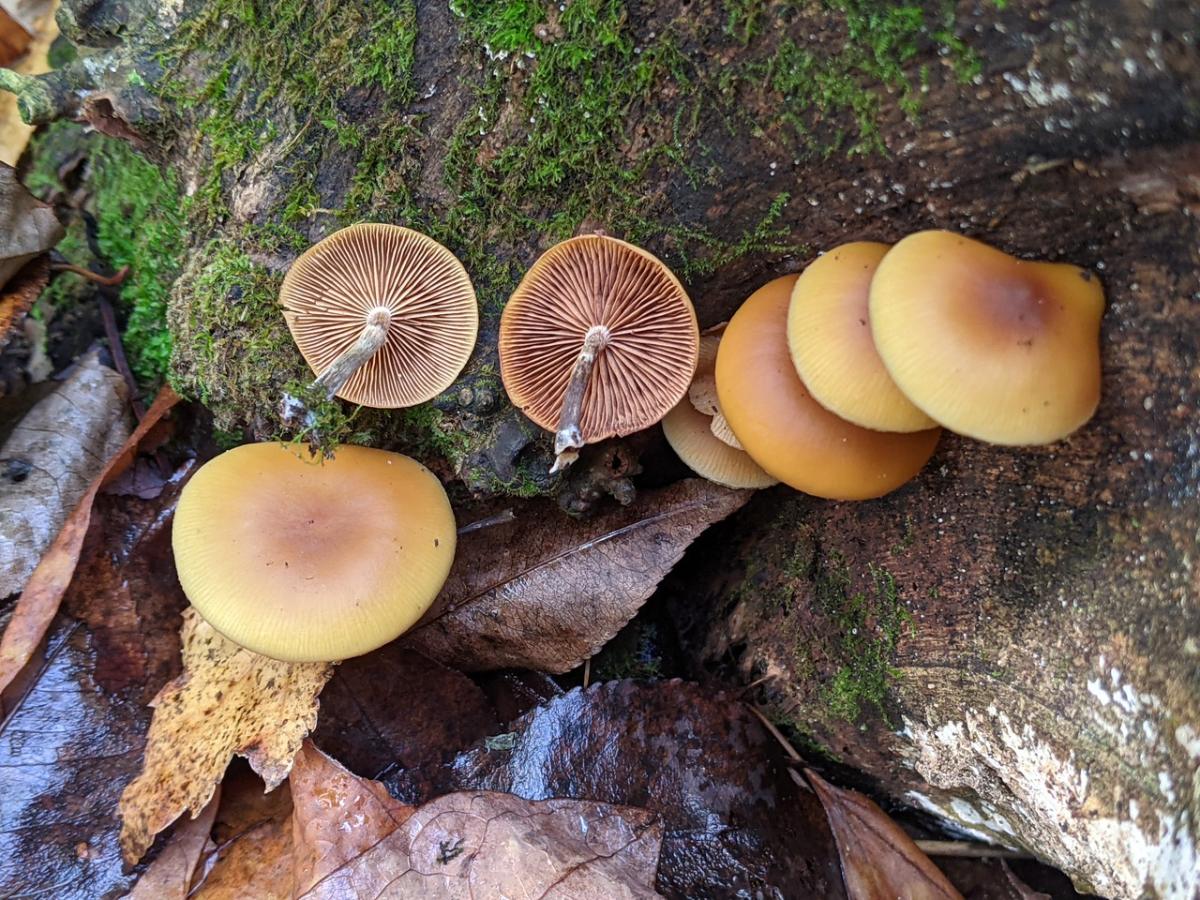
Sulfur Tuft (Hypholoma fasciculare)
The sulfur tuft is another dangerous lookalike that has a lot in common with the honey mushroom. This forager has even seen them fruiting on the same log — it is so important to check every.single.mushroom you find!
Sulfur tufts have brownish yellow caps and grow in dense overlapping clusters on dead and decaying wood. From above, they look extremely similar to honey mushrooms. Overall, they are smaller but can be confused with young honey mushrooms at this stage.
The primary differences are the gill color, which is never white. They start out yellowish and then turn greenish yellow. When young, they have a ring around their stem but that often falls off, leaving behind just a line around the upper stem. The flesh is yellowish, unlike the honey mushroom which has bright white flesh. Do a spore print if there is any question!
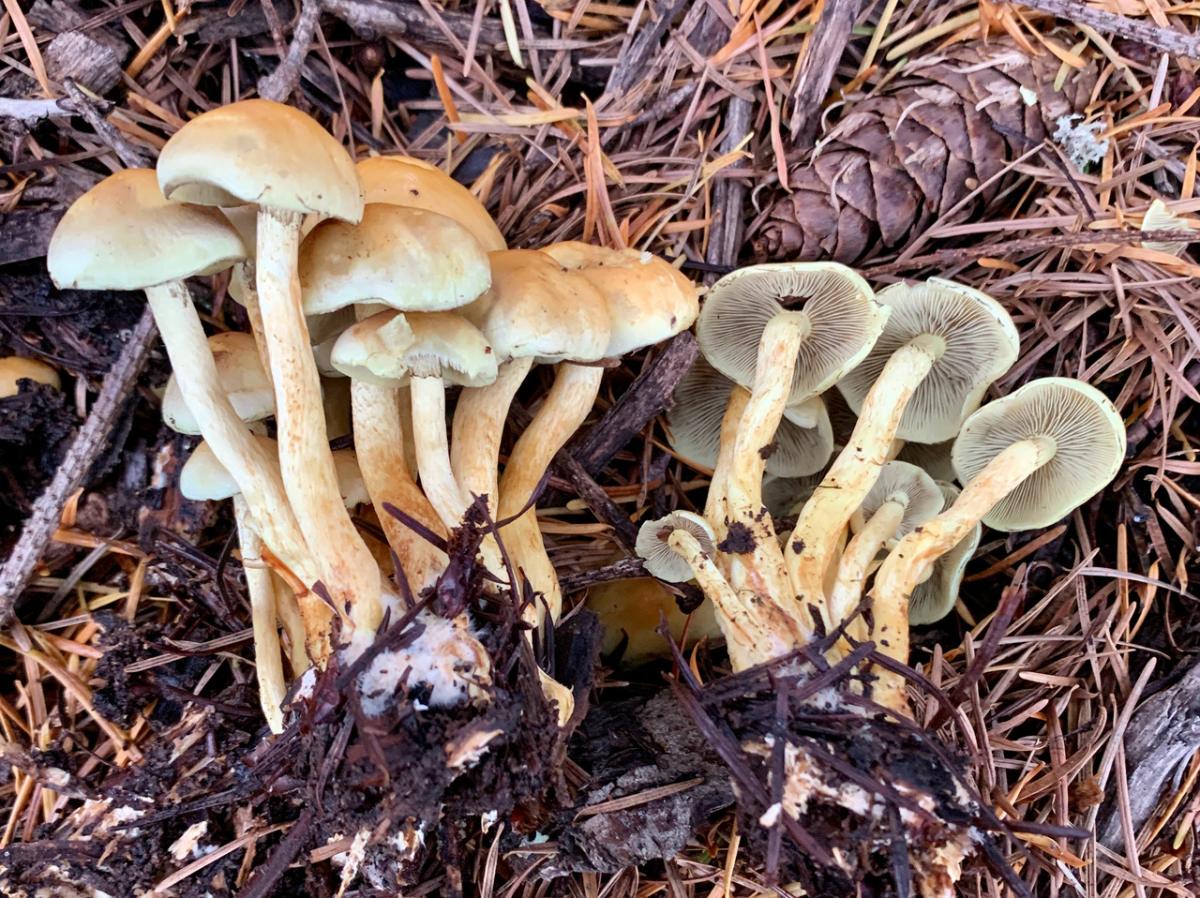
Shaggy scalycap (Pholiota squarrosa)
There are several Pholiota species like the shaggy scalycap that grow at the same time as honey mushrooms and in the same manner. They fruit in dense clusters around the base of trees or around decaying wood. Their caps are brown but are usually very scaly all over. Their stems also tend to be very scaly. The honey mushroom might have a felt-like or fibrous material on the stem, but it is not as pronounced or protruding as the scaly cap. They also have darker gills and brownish spore prints. Again, if there is ever a doubt, do a spore print!
Pholiota species aren’t deadly but they will likely give you severe gastrointestinal distress.
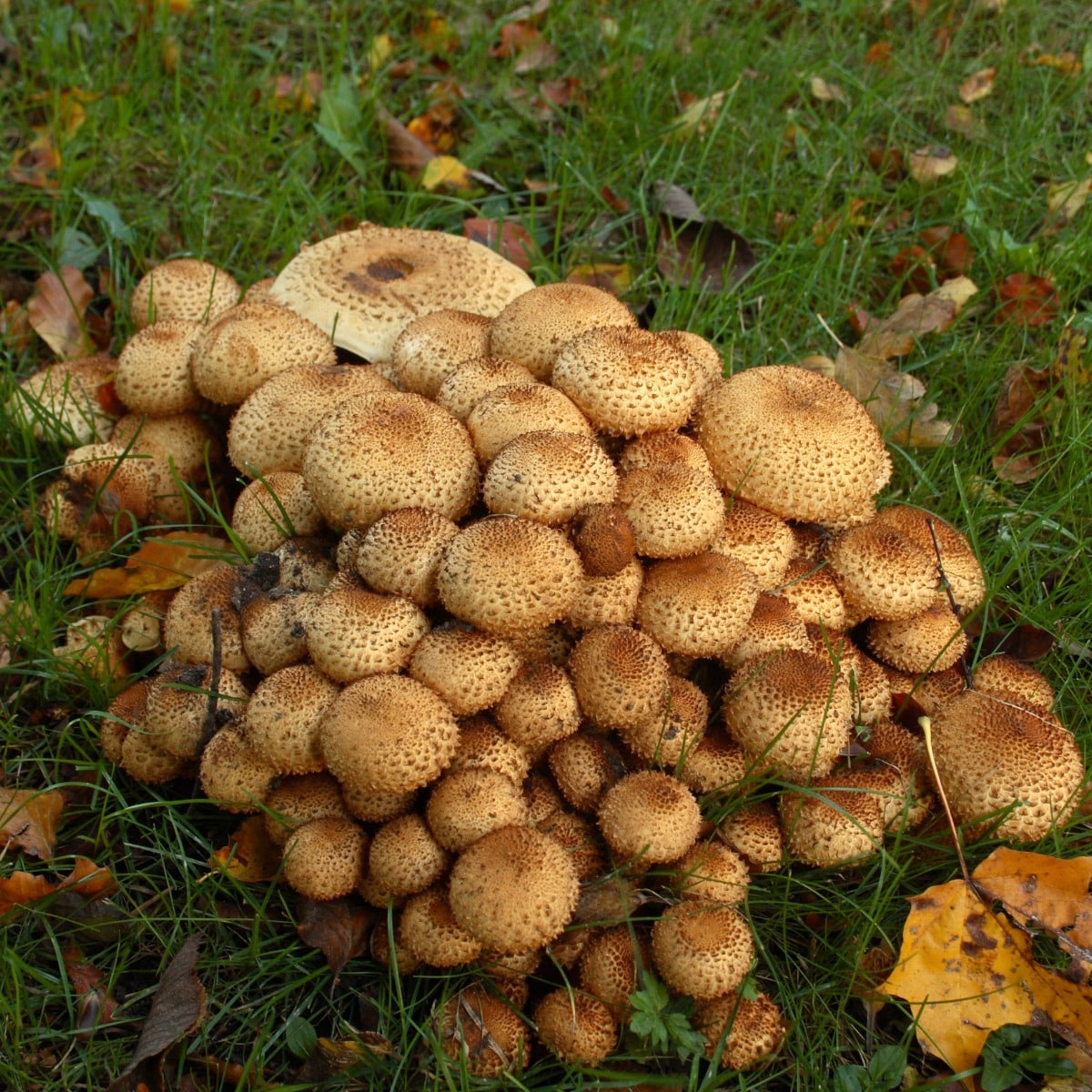

Velvet shank (Flammulina velutipes)
The velvet shank, aka enoki or winter mushroom, is also brown and grows on wood in similar clusters but it lacks a ring around the stem. Enoki are smaller, too, and much stickier or slimy looking. Their caps usually glisten a bit while honey mushrooms are duller overall.
This is an edible mushroom and quite a good one, but because it looks even more like the deadly galerina than the honey mushroom, you have to be extremely mindful foraging this species.
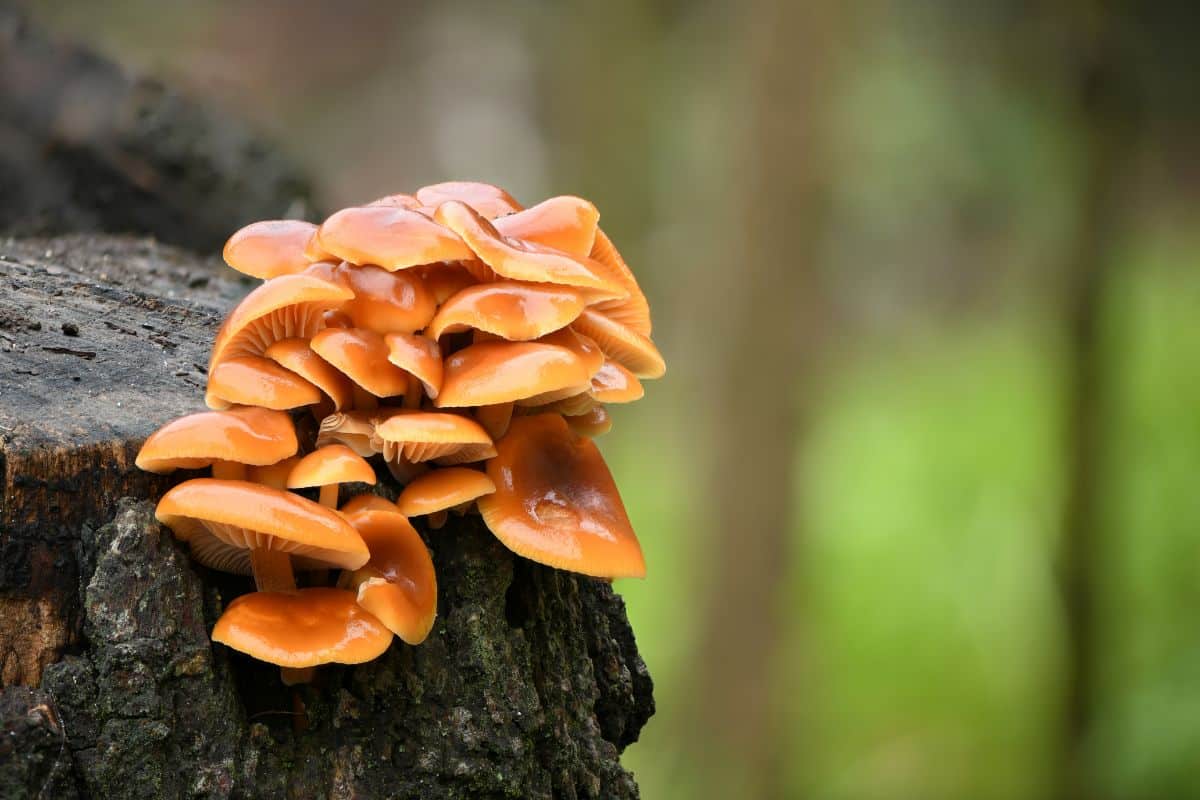
Jack-o’-lantern (Omphalotus illudens)
The jack o lantern mushroom is a toxic species with an orange, smooth cap. It can be confused with the honey mushroom because it grows at the same time of year in very dense clusters on dead and decaying wood. The caps are extremely orange to brown, though — much darker than a honey mushroom. Their gills and stem are also orange, in contrast to the honey mushrooms whitish gills and white to brown stem. Jack o’lantern flesh is light orange. The spore print is white, same as the honey mushroom, so that won’t help in this case.
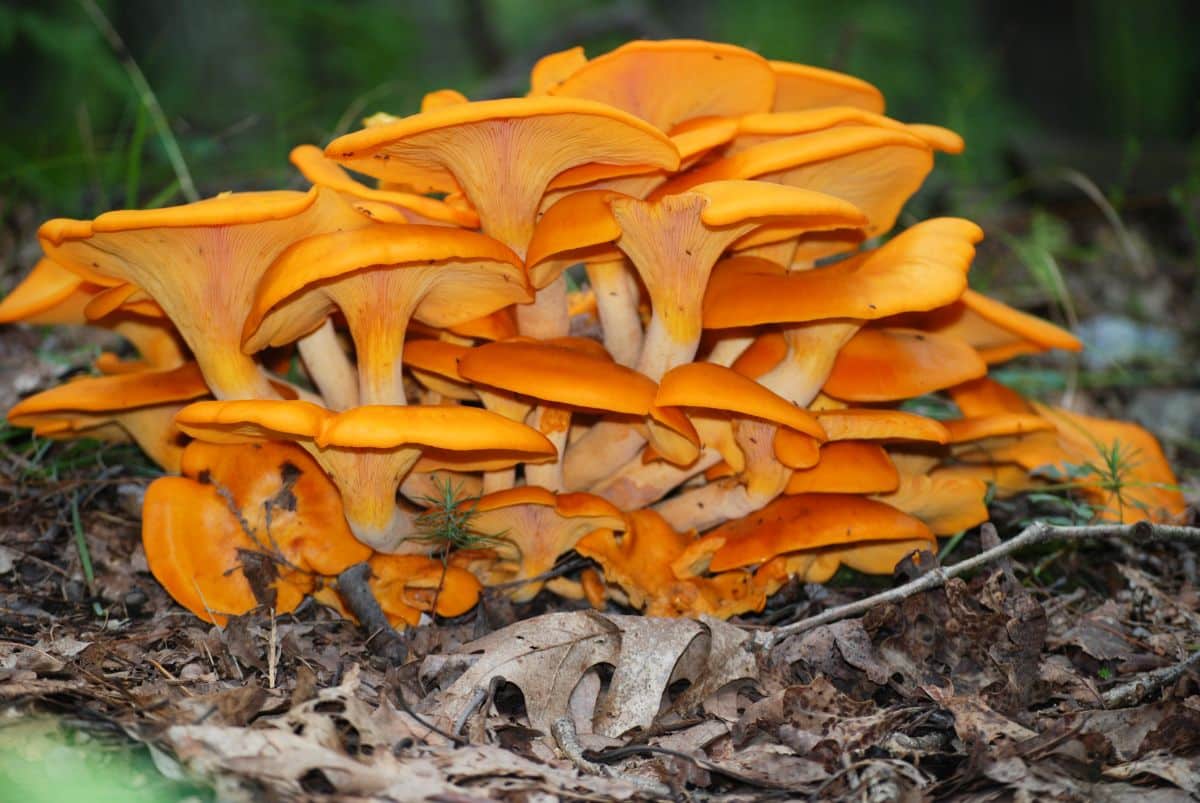
Big Laughing Gym (Gymnopilus junonius)
This mushroom is orange-brown and robust like the honey mushroom. It also has a ring around the upper stem. Big laughing gyms, though, have yellowish or brown gills and a orange brown spore print. The flesh is yellowish orange, in contrast to the honey mushrooms white flesh. These mushrooms are toxic.
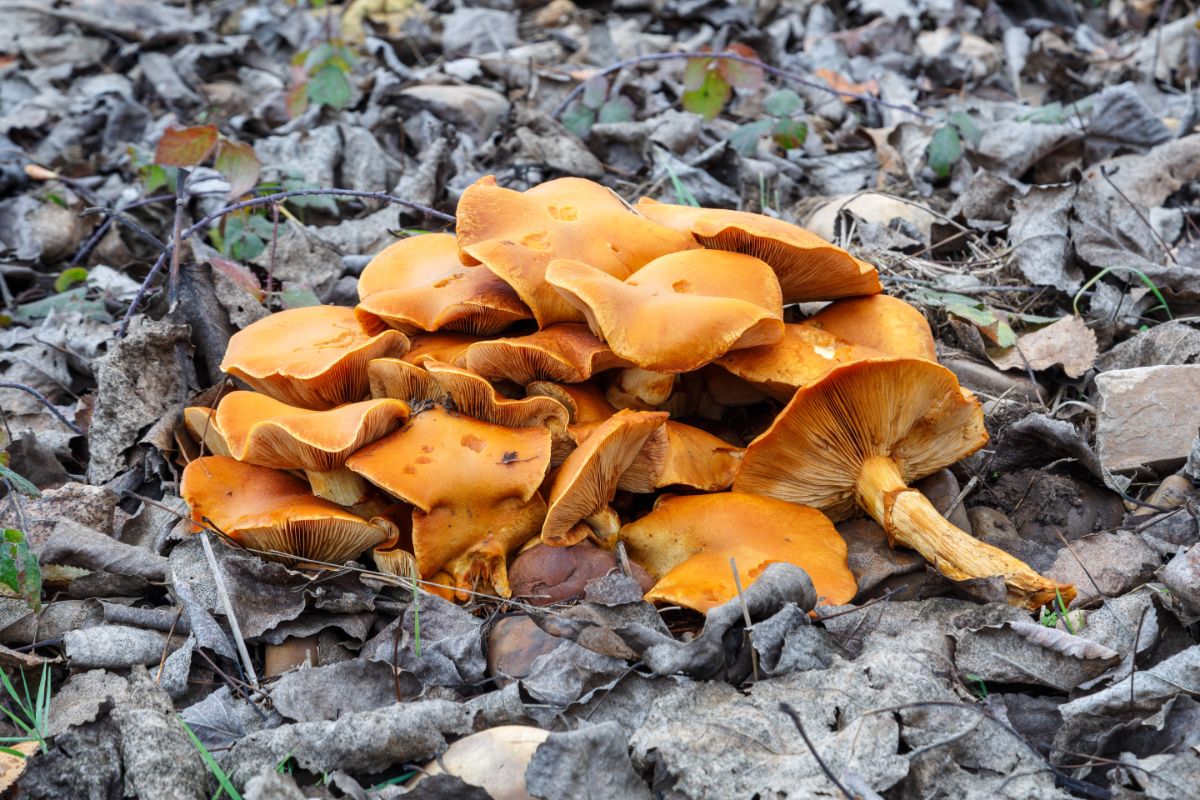
Cooking With Honey Mushrooms
Even when correctly identified, honey mushrooms can cause digestive issues in some people. Some individuals may experience acute gastrointestinal problems, ranging from mild discomfort to severe symptoms like uncontrollable diarrhea. It’s advisable to try a very small amount, such as a single cap, for the first time. If well-tolerated, gradually increase the portion size in subsequent meals. It’s also important to note that consuming alcohol with honey mushrooms is not recommended, as it may lead to adverse reactions.
The cause of the gastrointestinal distress may be allergic, which is a possibility with any wild mushroom. Or, it may be that the mushrooms weren’t cooked thoroughly enough. Or, in combination with undercooking, possibly also overindulgence because the mushrooms are so abundant. When you harvest 20-50 pounds (and easily!), it is easy to overdo it. Whatever the cause, go slow with these and only eat a little bit at a time the first few times trying it. And also, make sure you cook them very well.
Check out our more complete guide on How To Prepare Honey Mushrooms: Cleaning, Prepping, and Cooking.
Cooking Requirements
Honey mushrooms should never be eaten raw. Proper cooking is essential to ensure safety and improve digestibility. Experts recommend boiling the mushrooms in lightly salted water for at least 10 minutes before using them in recipes. This process helps remove compounds that may cause digestive distress. After boiling, the mushrooms can be incorporated into various dishes. Remember, even with proper cooking, some individuals may still experience adverse reactions.
Honey mushrooms have a sweet, slightly nutty flavor with a rich umami quality. This distinctive flavor makes them a tasty ingredient in various dishes. Their texture is crisp to crunchy or even chewy, depending on how they’re prepared. The caps, especially young ones, are dense and hold up well during cooking. These mushrooms can be sauteed, stir-fried, roasted, braised, added to soups and stews, used a pizza topping, or pickled. They are extremely versatile.
Honey Mushroom Recipes
- Honey Mushroom Pierogies
- Honey Mushroom Paprikas
- Marinated Honey Mushrooms
- Honey Mushroom Relish, Honey Mushroom Salad
- Pickled Honey Mushrooms
- Hot and Spicy Honey Mushroom (Canning recipe)
- Honey Mushroom Risotto
Preserving and Storing Honey Mushrooms
Drying Methods
Honey mushrooms can be dried and this actually enhances their flavor. Slice the caps thinly and place them on wire racks in a warm, dry area with good air circulation. Alternatively, use an oven set to the lowest ‘warm’ setting, with the door propped open slightly. Dry until crispy, usually within 12-24 hours. Store dried mushrooms in airtight containers for up to a year. To rehydrate, soak in warm water for about an hour, reserving the flavorful soaking liquid for cooking.
Freezing Techniques
Freezing honey mushrooms requires a two-step process. They need to be cooked before freezing because their texture takes a nose-dive when frozen raw. First, sauté them in butter or oil (about two tablespoons per cup of mushrooms) over medium heat until they’ve released their liquid and reabsorbed it. Let cool, then freeze in portion-sized containers or bags. Alternatively, blanch the mushrooms in boiling water for 3 minutes, air-dry for 30 minutes, then freeze in heavy-duty bags for up to six months.
Pickling and Brining
Pickling and salt brining are long-term preservation methods for honey mushrooms. For salt brining, boil cleaned mushrooms for 10-15 minutes, then layer them with sea salt in a jar. Cover them with water and store them in a cool place for up to two years. Before using, soak in fresh water for two days to remove excess salt. This method maintains excellent texture and flavor.
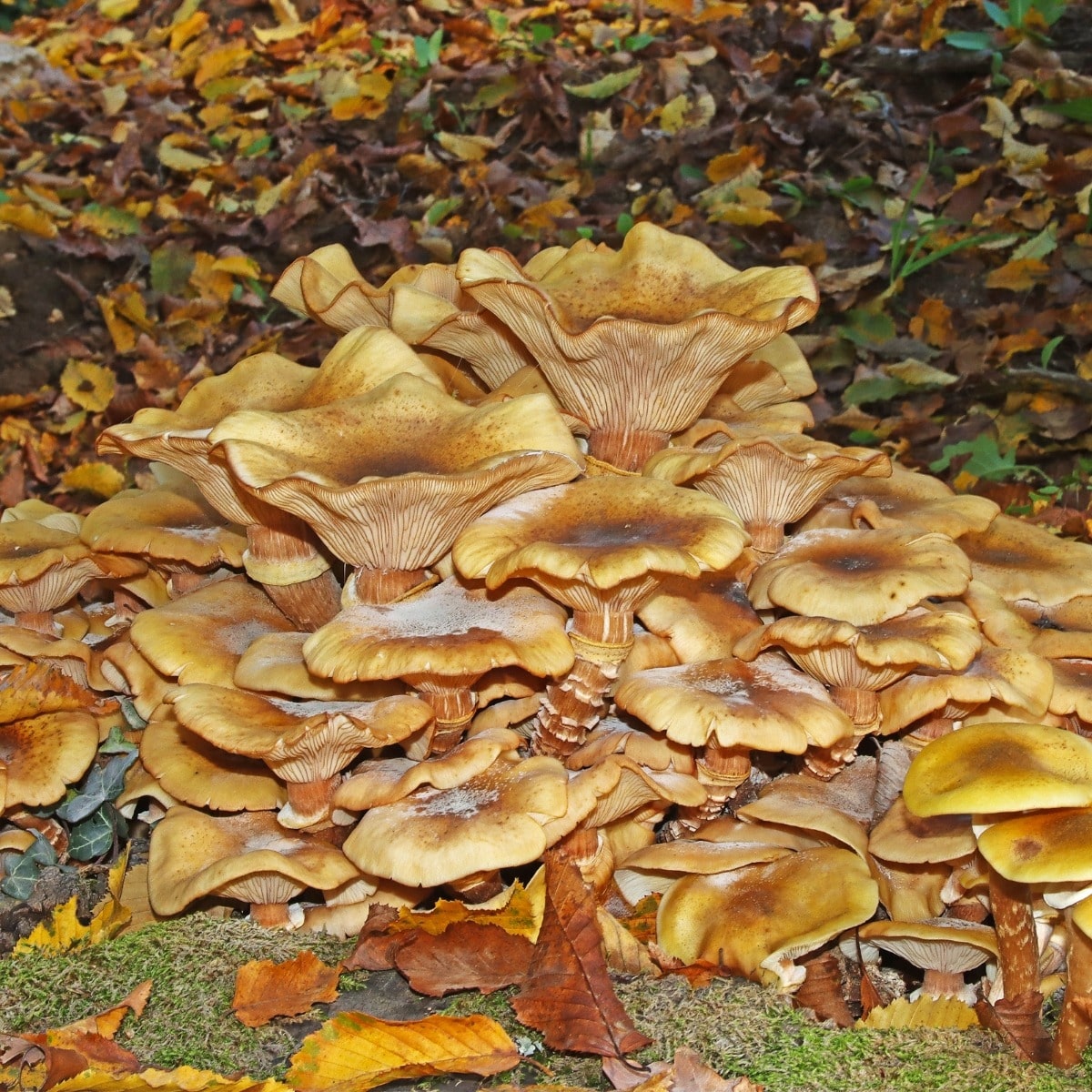
Honey Mushroom Ecology
Life Cycle
Most of the time, honey mushrooms exist as a network of cells called mycelium, penetrating the tissues of living trees. The fungus spreads through probing and searching rhizomorphs, which can grow up to 50 meters (164 feet!) between food sources. This allows genetically distinct networks to cover vast areas of forest. The above-ground fruiting bodies appear in fall, growing, spreading their caps, and shedding spores. As they decay, their deteriorating bodies are food for many insects and small animals who, in turn become food for larger animals.
Relationship with Trees
Honey mushrooms are parasitic plant pathogens and saprophytes, meaning they can feed on both living and dead trees. The aggressiveness of their parasitism varies depending on the species. For example, Armillaria mellea and A. ostoyae are considered the most aggressive killers, while A. gallica often infects plants already suffering from environmental stress or other infections. Honey fungus causes a white rot, breaking down the lignin in wood and leaving it soft and pulpy. This process can be destructive to individual trees but beneficial to the overall forest ecosystem.
In some cases, the fungus alone causes the tree’s death, but they also are opportunistic and take advantage of insect or other damage to invade the tree.
Identifying Honey Fungus Infection In Trees
Honey fungus infection manifests through various signs:
Early Indicators:
- Spring foliage is scarce or dies back
- Rhizomorphs (mycelial cords) visible under bark and surrounding the tree
- Autumnal mushroom clusters on infected plants, disappearing after frost
Confirmatory Signs:
- Cream-colored mycelial sheets beneath bark at the trunk or stem base
- Strong mushroom odor
- Fungal growth
Conifer-Specific Symptom:
- Gum or resin secretion from bark fissures
How To Get Rid Of Honey Mushrooms
This fungus is a primary contributor to tree and shrub death in both wild and cultivated environments, resulting in consistent and significant damage to plant populations. If you have them growing on trees in your yard or forest, you might want to try removing them.
However, this is basically an impossible task. The mycelium is in the tree, under the bark, and in the soil; there is no way to remove it entirely. You can remove the fruiting honey mushrooms, but the aboveground mushroom is only part of the equation. Removing them early prevents them from spreading spores but does not eliminate the current infection.
On the plus side, the tree or shrub death usually isn’t immediate. It depends on the age of the tree, but total death can take decades:
- Young trees – these are usually killed quickly after they’re infected because they have fewer natural defenses.
- Well-established trees – These trees can be infected for decades without showing major signs or symptoms. But if the tree is weakened by insect defoliation, or disease, it may decline more rapidly.
- Large trees – Larger trees might survive for several years even after the first symptoms show up.
There are currently no proven fungicides or management practices that can eliminate Armillaria mellea after infection without harming the infected plant. However, research in this area is ongoing. Certain practices can help prolong the life of affected plants and prevent further spread of the disease.
The most effective approach to extending plant life is by improving the tree’s condition through supplemental watering and fertilization. To prevent further spread of the honey fungus, several measures can be taken:
- regulate irrigation to avoid water stress
- keep the root collar dry
- remove stumps
- provide adequate fertilization
- avoid physical root damage and soil compaction
- refrain from planting susceptible tree species in areas with documented Armillaria mellea.
There is also evidence suggesting that biological control using the fungus genus Trichoderma may be beneficial. Trichoderma, a natural predator of Armillaria mellea, thrives in woodchips. Therefore, chipping or grinding dead and infected roots can create an ideal habitat for Trichoderma, promoting its growth. Solarization is another technique that can create favorable conditions for Trichoderma while simultaneously creating poor conditions for Armillaria mellea, as the fungus prefers dry soil and higher soil temperatures.
The Curious Case of Entoloma abortivum and Armillaria
When Entoloma abortivum encounters the honey mushroom, a fascinating transformation occurs. The Entoloma infects the honey mushroom’s mycelium, causing it to fruit into an unusual, knobby white mass instead of its typical form.
Foragers seek out this peculiar growth, dubbed “shrimp of the woods,” for its distinctive appearance and fabulous taste. You might find it categorized under Armillaria or Entoloma in mushroom guides.
The history of shrimp of the woods is complicated. For over a century, experts mistakenly believed these lumpy white formations were simply malformed or “self-aborted” Entoloma abortivum specimens. Despite noticing Armillaria species often growing nearby, mycologists and foragers did not connect the two. Many mushrooms grow in proximity to each other, but that doesn’t usually mean they are related or tied together.
In 1971, Watling’s research revealed the presence of Armillaria cells within aborted Entoloma fruiting bodies. This observation led to the conclusion that Armillaria was parasitizing Entoloma, a hypothesis widely accepted by mycologists due to Armillaria’s known parasitic nature.
This explanation persisted for decades. However, a 2001 study overturned this long-held belief, demonstrating that Entoloma was actually the parasitic aggressor, with Armillaria as its victim. The study proposed that the parasitized white lumps should retain the name Entoloma abortivum since it is the actual aggressor. Ironically, given this revelation, one might argue that “aborted Armillaria” could be a more fitting description.
Entoloma abortivum is a versatile parasite; it targets multiple Armillaria species rather than a single honey mushroom host. This fungus parasitizes honey mushrooms when available but also functions as a decomposer of forest debris when no honey mushrooms are around to invade. Its adaptability and strategic approach likely serve as evolutionary advantages for this parasitic species. Further research is necessary to understand the intricate interactions between these fungi and the precise mechanisms of parasitism.
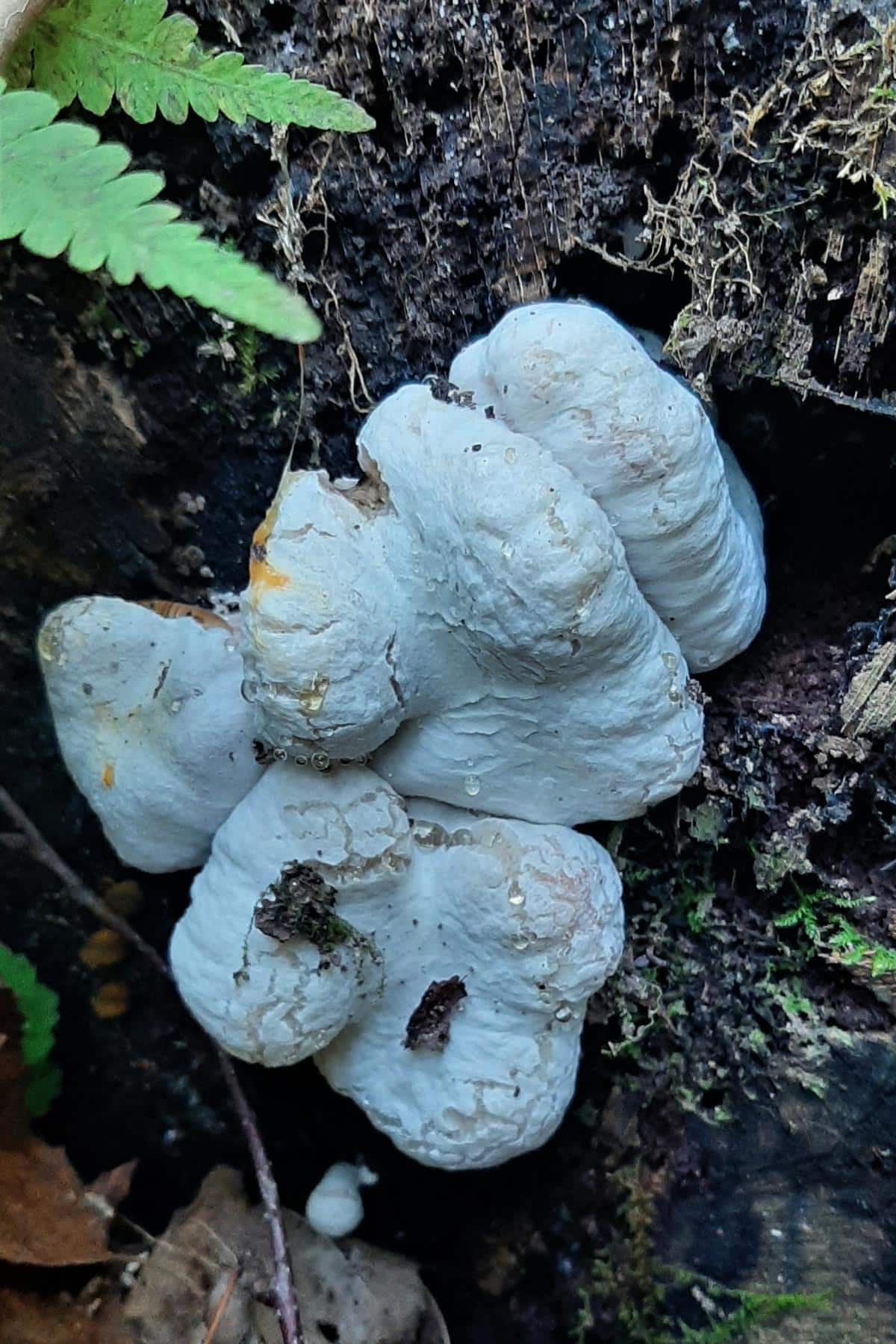
Honey Mushroom Medicinal Uses And Research
Recent scientific investigations have unveiled promising medicinal properties of honey mushrooms. Studies suggest they possess anti-inflammatory and antioxidant properties, potentially helping combat chronic inflammation and reduce oxidative stress. Some research indicates possible neuroprotective effects, which could play a role in preventing or treating neurodegenerative diseases.
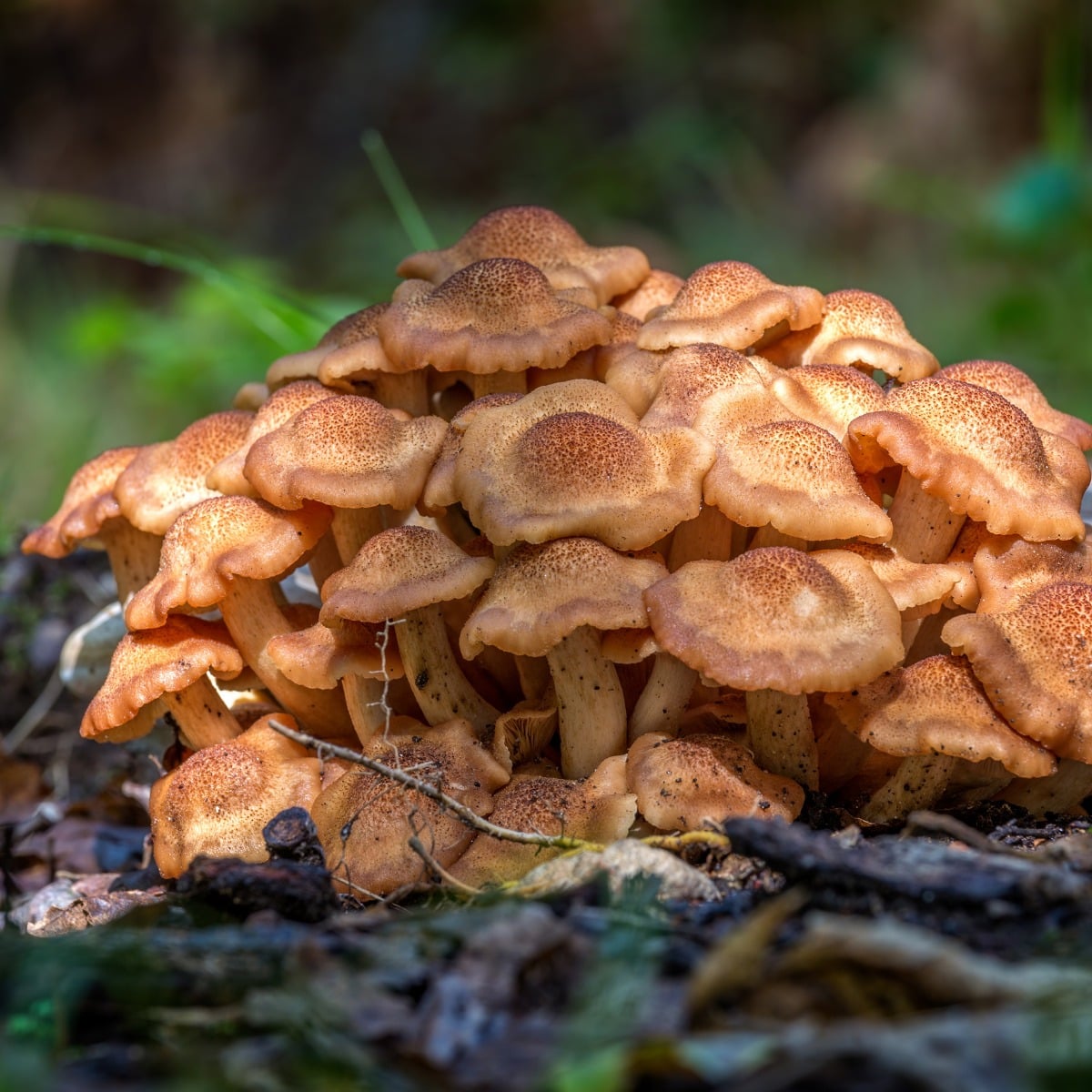
Common Questions About Honey Mushrooms
Are honey mushrooms edible?
Yes, all honey mushrooms are generally considered edible. However, it is essential to exercise caution and properly identify them before consuming, as there are some toxic lookalike species. If you are unsure about the identification of a mushroom, it is best to consult with an experienced mycologist or avoid consuming it altogether.
What do honey mushrooms taste like?
Honey mushrooms, (Armillaria) have a mild, slightly sweet flavor profile with subtle nutty undertones and earthy, woody notes. When cooked, they develop a firm yet tender texture, with the caps becoming pleasantly chewy while the stems retain a bit more fibrous consistency. Their taste is often compared to shiitake mushrooms, albeit milder, and they share some similarities with oyster mushrooms, particularly in their hint of sweetness.
Where are honey mushrooms found?
Honey mushrooms are widely distributed across North America. These adaptable fungi thrive in various forest ecosystems, including deciduous, coniferous, and mixed woodlands. They can be found in numerous regions, from the Eastern United States and the Pacific Northwest to the Rocky Mountains and parts of Canada.
Notable areas for honey mushroom populations include Oregon’s Malheur National Forest, home to a massive colony, the Northeastern United States, where they are particularly abundant, and the Great Lakes region.





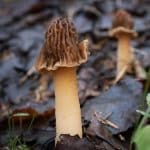
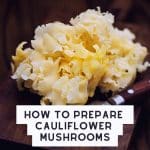
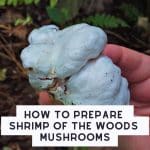
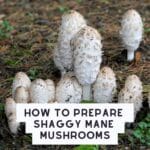
Leave a Reply